Roberta González & Sergio de Castro
Exhibition: July 7 – September 27, 2025
Though Roberta González and Sergio de Castro may never have crossed paths, the parallels in their personal lives and artistic trajectories merit being brought to light. Bringing the two artists Face to Face, this exhibition seeks to explore their work centred around the human figure in the context of the 1950s
TWO HISPANIC ARTISTS IN PARIS
Roberta González and Sergio de Castro were Hispanic artists, both of whom lived and worked mainly in Paris. Roberta González was born in France and brought up in the Catalan community of Paris’ Montparnasse neighbourhood. Her participation in the 1936 exhibition L’art espagnol contemporain (Contemporary Spanish art) at the Musée des Écoles Étrangères Contemporaines clearly marked her swift integration into the Franco-Spanish art scene. Roberta also expressed her support for Republican Spain from 1936 onwards.
Sergio de Castro was born in Buenos Aires, Argentina, to parents of Spanish origin. He spent his youth between Europe (Switzerland and Italy) and Latin America (Uruguay and Argentina). Awarded a scholarship by the French government in 1949, he settled permanently in Paris that year, also in the city’s Montparnasse neighbourhood. He became a naturalised French citizen in 1979.
HISPANIC MASTERS
Roberta González and Sergio de Castro’s earliest artistic mentors were also prominent Hispanic artists: the Spaniard Julio González (1876-1942) for Roberta and the Uruguayan Joaquín Torres García (1874-1949) for Sergio. From these formative teachings, both artists developed a geometric approach to form and a fundamental interest in line.
It is interesting to note that Julio González, Roberta’s father, also maintained close artistic and personal connections with Joaquín Torres García. Julio González was closely aligned with the latter’s Constructivist movement “Cercle et Carré” (“Circle and Square”) group, although he never officially joined it. Roberta González, on the other hand, was good friends with Olimpia Torres, the daughter of Joaquín Torres García. Roberta stayed with her in Madrid during a visit to Spain in 1936, just before the war.
It is also important to highlight a major influence shared by Roberta González and Sergio de Castro: the Spanish painter Pablo Picasso. Picasso was present early on in Roberta González’s life; he was a friend of her father Julio and a regular visitor to their family home. He is even said to have encouraged the young artist to take up drawing. From the 1930s onward, Roberta González naturally embraced a style shaped by Cubist influences.
Sergio de Castro met the Spanish Cubist master in 1952. They exhibited together at the Galerie Charpentier in 1955. The admiration between the two artists was mutual, Picasso being particularly interested in two small gouaches by Castro representing his studio. The two painters shared common sources of inspiration, particularly preColumbian art. The simplification of forms that they admired in primitive artworks fostered a geometric approach to form in both painters’ works.
ARCHITECTURE
Roberta González and Sergio de Castro’s interest in line and geometry led the two painters to the world of architecture. Sergio de Castro studied architecture for a year in 1939 at his father’s request. This influenced not only his painting, but also the layout of his studio in the 14th arrondissement of Paris. Sergio de Castro occupied the same studio from 1953 to 2012.
Roberta González designed the plans for her studio and house in Bormes-lesMimosas (in the Var department) in 1960. She would spend much of the last fifteen years of her life there.
PORTRAITS OF WOMEN
The female figure played a significant role in the work of Roberta González and Sergio de Castro. In the 1930s, Roberta González paid tribute to Catalan women with paintings of peasant women and mother-and-child scenes. During the Second World War, she painted deformed female figures, bearing the marks of the violence of the conflict.
In 1950, Sergio de Castro suffered a series of severe asthma attacks, which led to an extended stay at the Necker Hospital. Although he was confined to bed, he drew a lot. During his stay, he drew inspiration from the nurses wearing white veils. Many of Sergio de Castro’s works from the 1950s feature female figures.
BETWEEN ABSTRACTION AND FIGURATION
Ultimately, Roberta González and Sergio de Castro both demonstrated a great degree of independence with regard to the debate between figuration and abstraction that was affecting the post-war art scene in France.
Roberta González was the daughter of the sculptor Julio González, who believed that art should always be rooted in nature. From 1939 to 1952, she was married to Hans Hartung, one of the pioneers of the Lyrical Abstraction movement, which advocated pure abstraction with no reference to reality. Roberta thus sought to synthesise these two seemingly irreconcilable artistic approaches. In 1951, she wrote: “The problems posed by abstraction haunt me in the same way as those posed by figuration. The most difficult thing is to establish a kind of synthesis of the two forms of expression. I’m looking for a kind of balance.” Two years later, she added that she felt “the need to juxtapose, to intermingle, the figurative form with geometric shapes. Thus, a figure or an animal stands next to a triangle, a circle, a square, or oblique lines, or interlocks with them… The geometric form expresses permanence, the unchanging shape – [while] the figurative form [conveys] mobility, plasticity, the form in movement, constantly transforming itself. By placing them in opposition on the canvas, a balance of instability and stability is created.” Roberta González’s compositions were built on the dualities of abstraction and figuration, and immobility and movement.
Sergio de Castro’s work was rooted in his reality: his surroundings, his objects, his studio… And yet, he maintained a high degree of independence from the formal reality of his subjects. “While he opts for a narrative style, any subject for him is above all a visual arts subject”, wrote the art historian Lydia Harambourg. The subjects were a pretext for the expression of line and colour. The writer André Chastel noted the following about Sergio de Castro: “He has not, therefore, felt challenged by the great contemporary debate on the antinomy of abstract and figurative, object and image. He intends to go forward without making a useless decision; he does not feel that it is necessary.”
The exhibition Face to Face reveals the profound resonances between Roberta González and Sergio de Castro. Their respective paths, shared influences, and mutual interest in the human figure and architecture shed light on an artistic affinity. Juxtaposing their works offers an interesting perspective on the post-war Parisian art scene, marked by a quest for balance between abstraction and figuration.
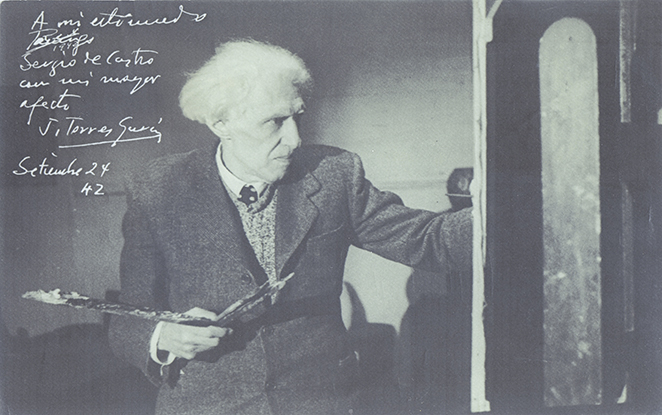
Photo of Joaquín Torres García signed «A mi estimado amigo Sergio de Castro con mi mayor afecto. J. Torres García. Setiembre 24 42 »
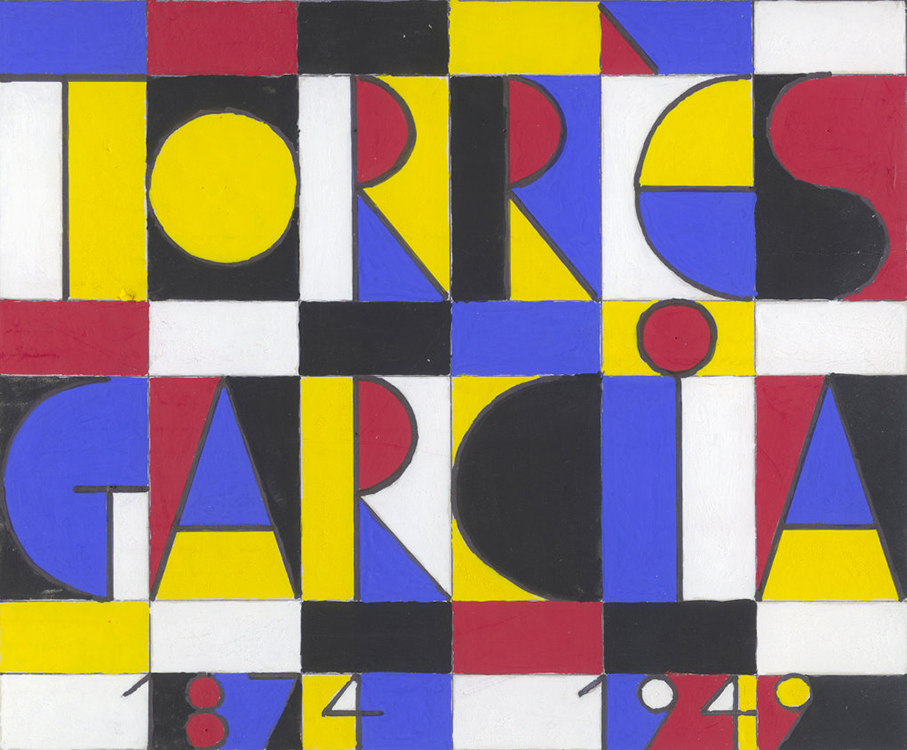
Cover artwork by Sergio de Castro from the book: Enríc Jardi, Torres GarcÍa, Barcelona, Ediciones Polígrafa, 1973
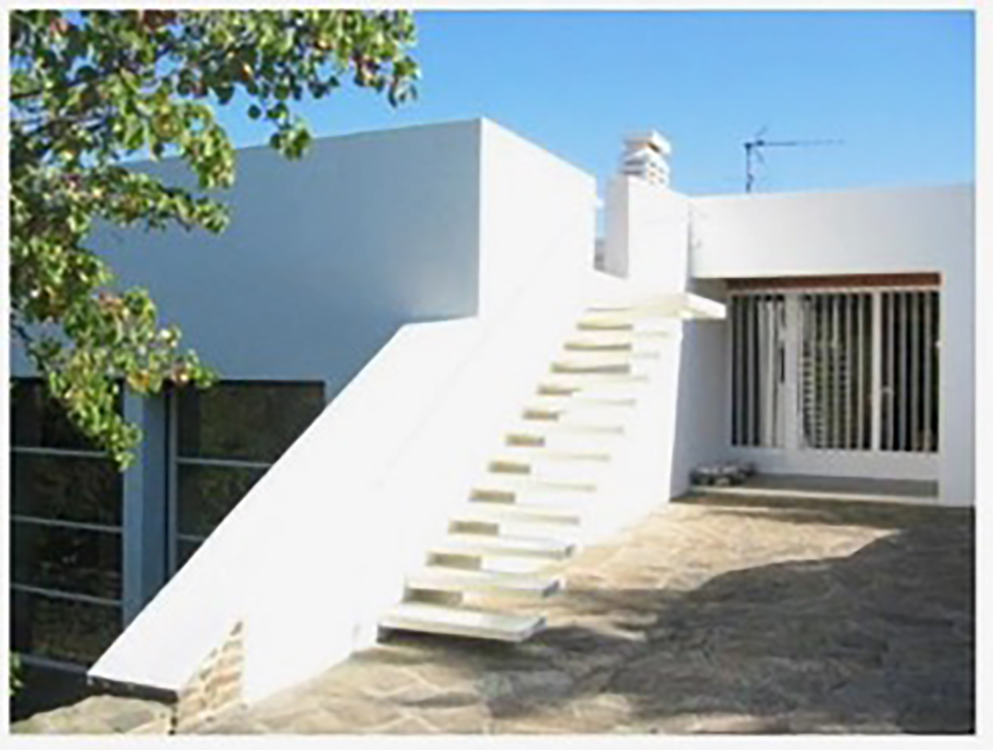
The studio house built from plans by Roberta González in 1960, Bormes-les-Mimosas Photo: Anne Pericchi Draeger
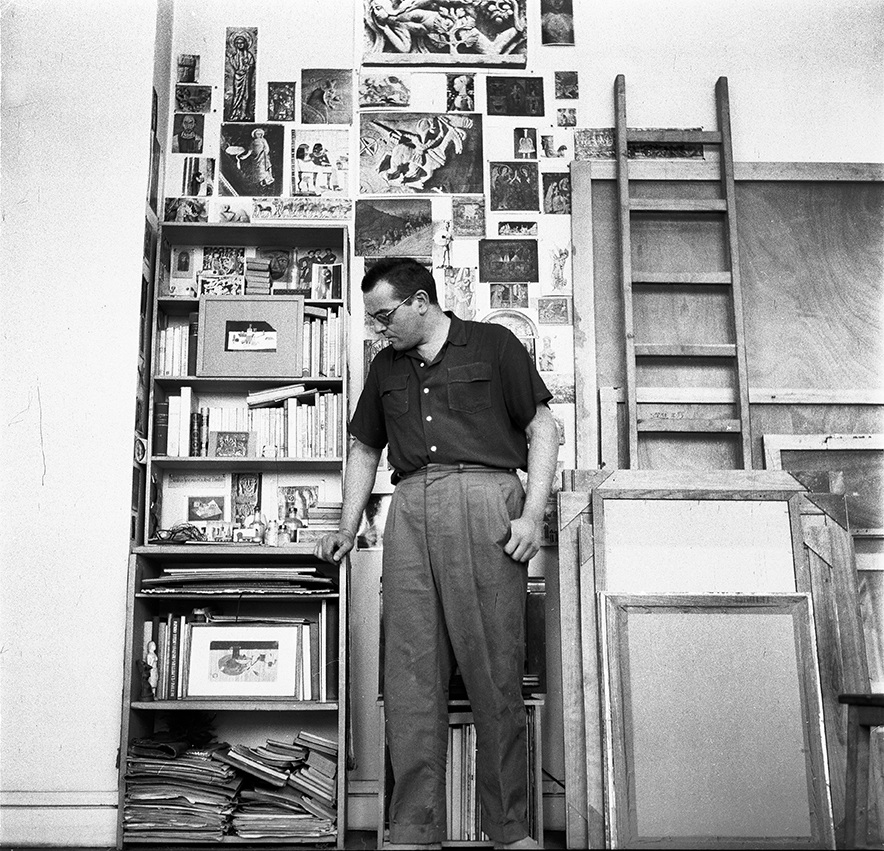
Sergio de Castro in his studio, Paris, 1955
Photo: Jose Antonio Mendia
Exhibited artworks
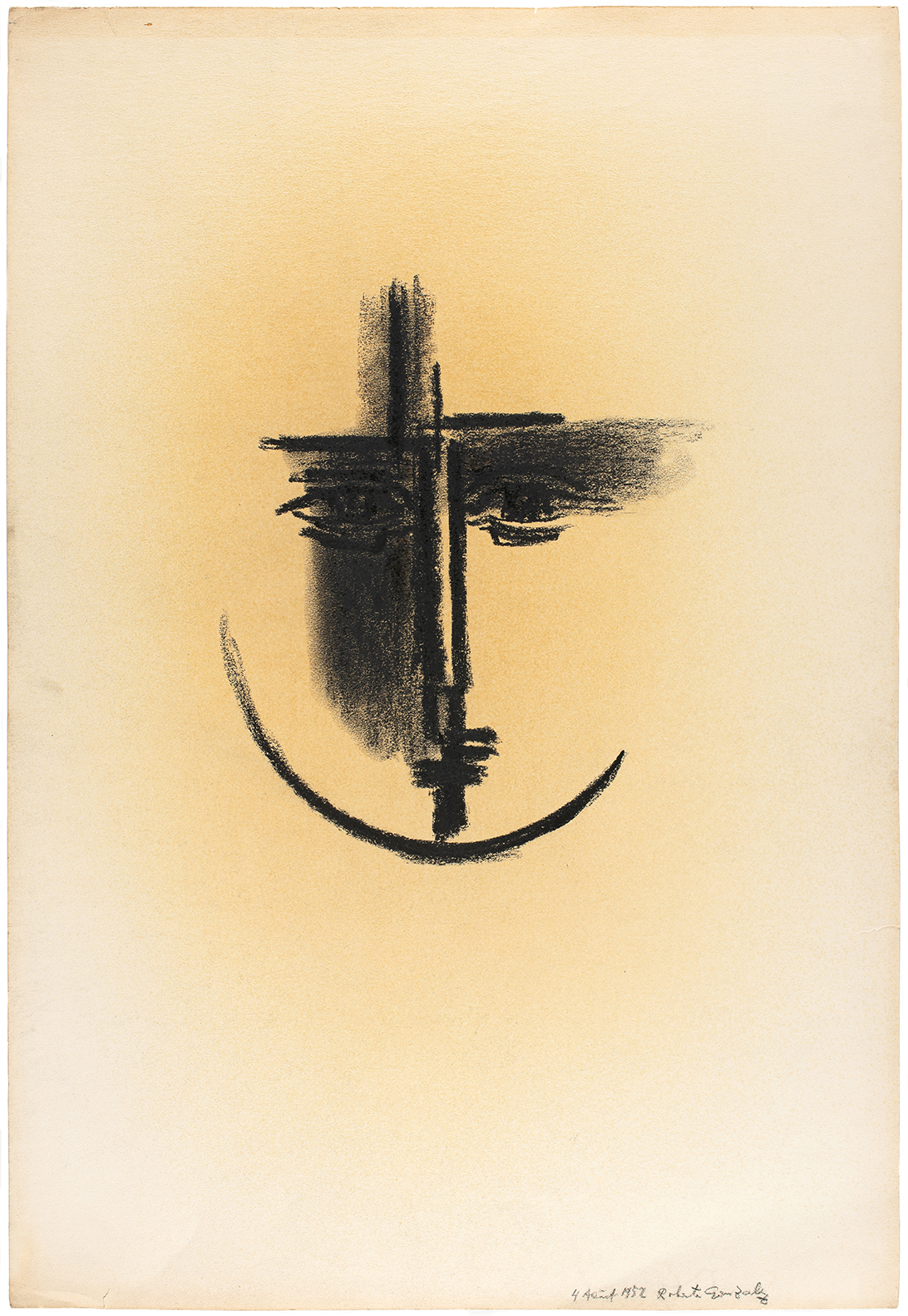
ROBERTA GONZÁLEZ (1909 -1976)
LE REGARD FIXE, 1952
Charcoal on paper
72,1 x 48,8 cm – 28 3/8 x 19 3/16 in.
Dated and signed “4 Août 1952 Roberta Gonzalez“ lower right
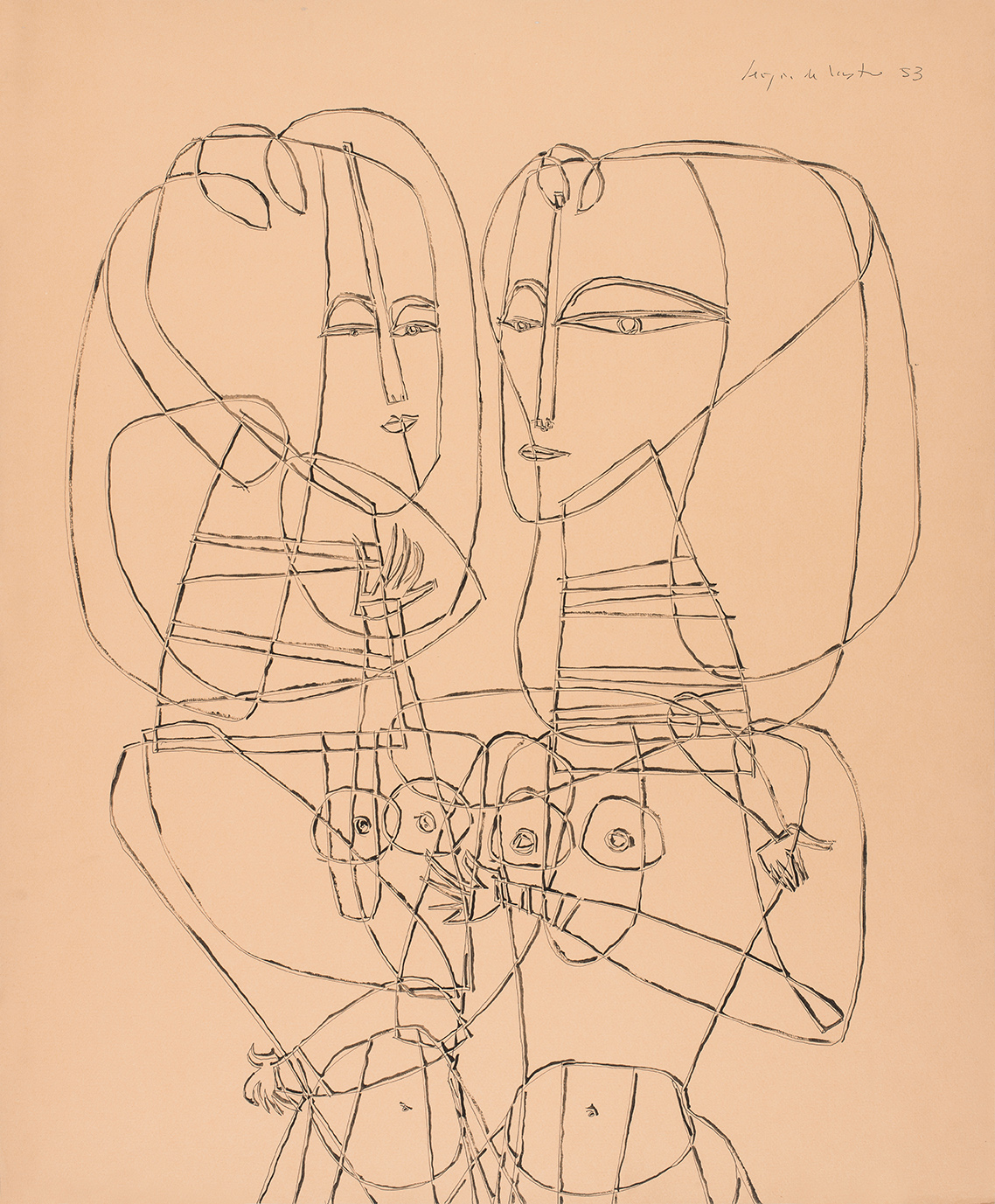
SERGIO DE CASTRO (1922 -2012)
DUO, 1953
Ink on tinted paper
61 x 50 cm – 24 x 19 11/16 in.
Signed and dated “Sergio de Castro 53“ upper right
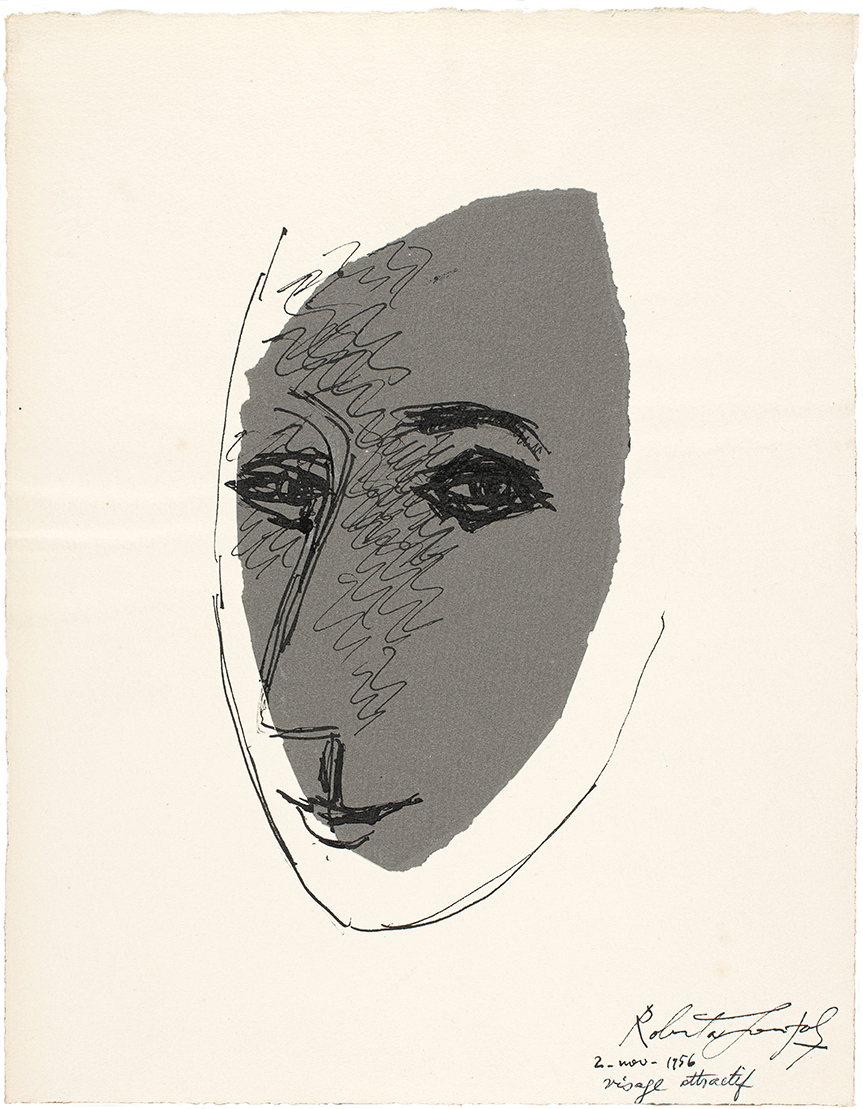
ROBERTA GONZÁLEZ (1909 -1976)
VISAGE ATTRACTIF, 1956
Pen and ink on paper
32,7 x 25,2 cm – 12 7/8 x 9 15/16 in.
Signed, dated and titled “Roberta Gonzalez 2-nov-1956 visage attractif“ lower right
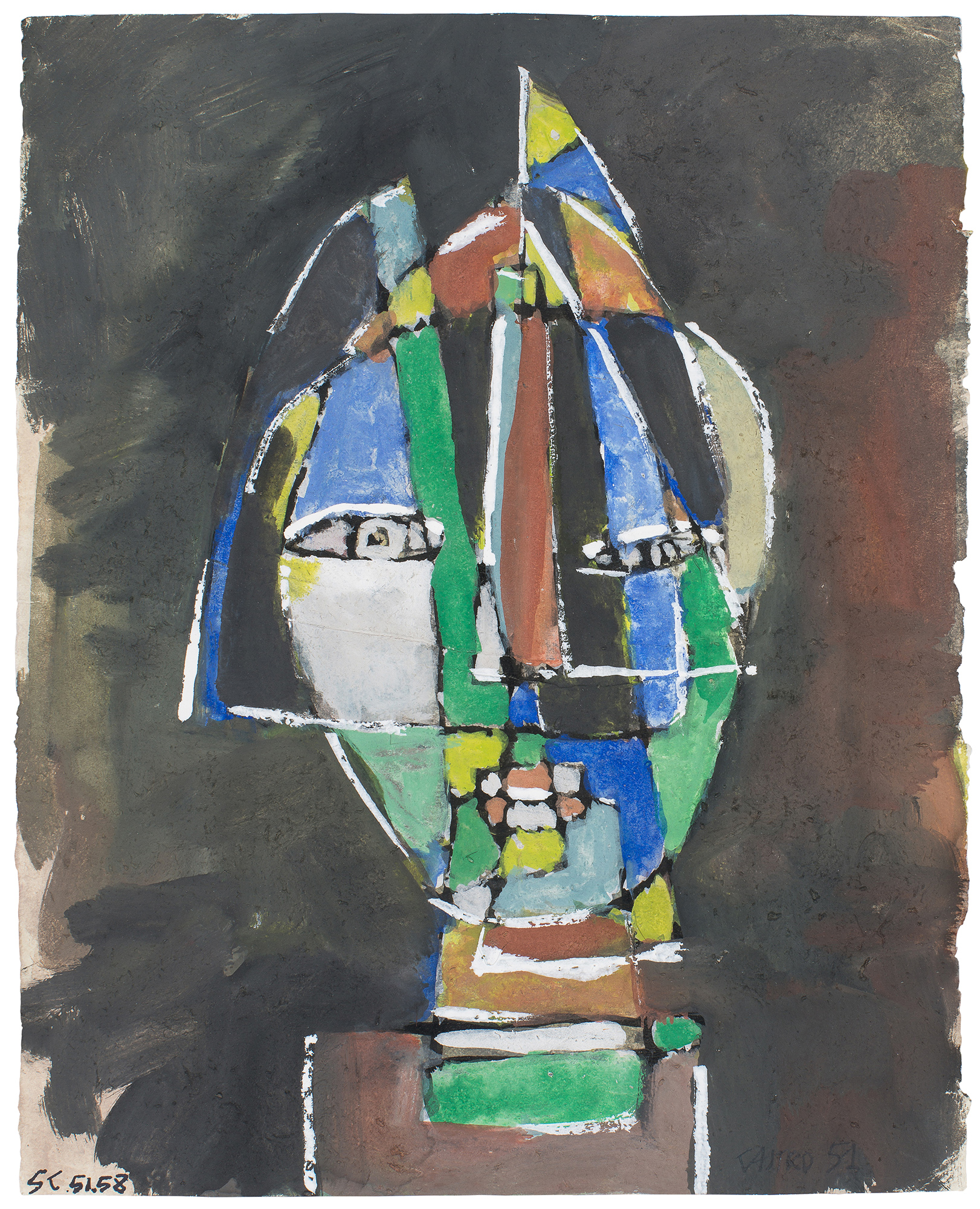
SERGIO DE CASTRO (1922 -2012)
UNTITLED, 1951
Gouache on paper
17,5 x 14 cm – 6 7/8 x 5 1/2 in.
Inscribed “SC 51.58“ lower left – Signed and dated “CASTRO 51“ lower right
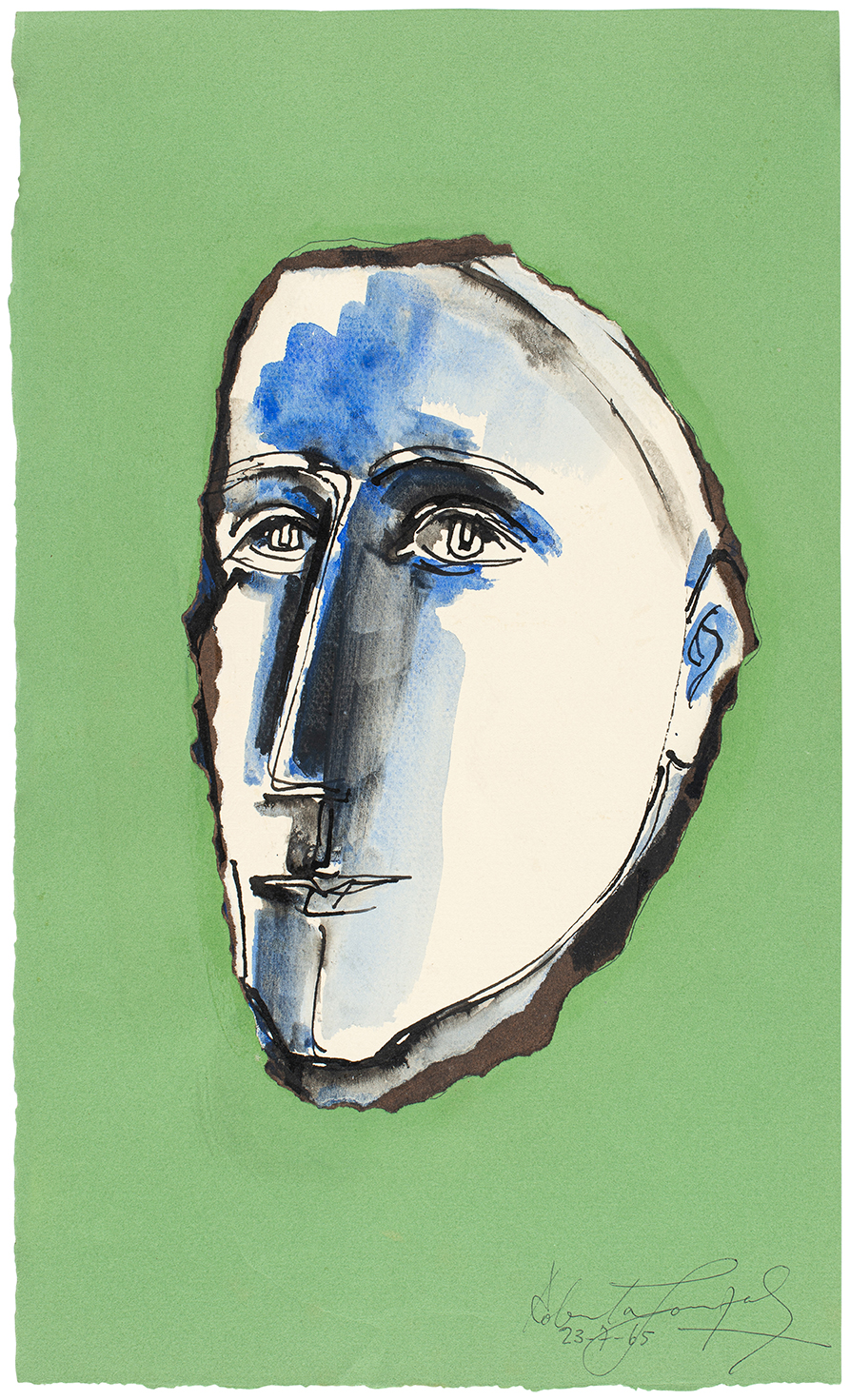
ROBERTA GONZÁLEZ (1909 -1976)
MASQUE BLANC ET VERT, 1965
Gouache and ink on tinted paper
41,5 x 24,7 cm – 16 5/16 x 9 3/4 in.
Signed and dated “Roberta Gonzalez 23-7-65“ lower right
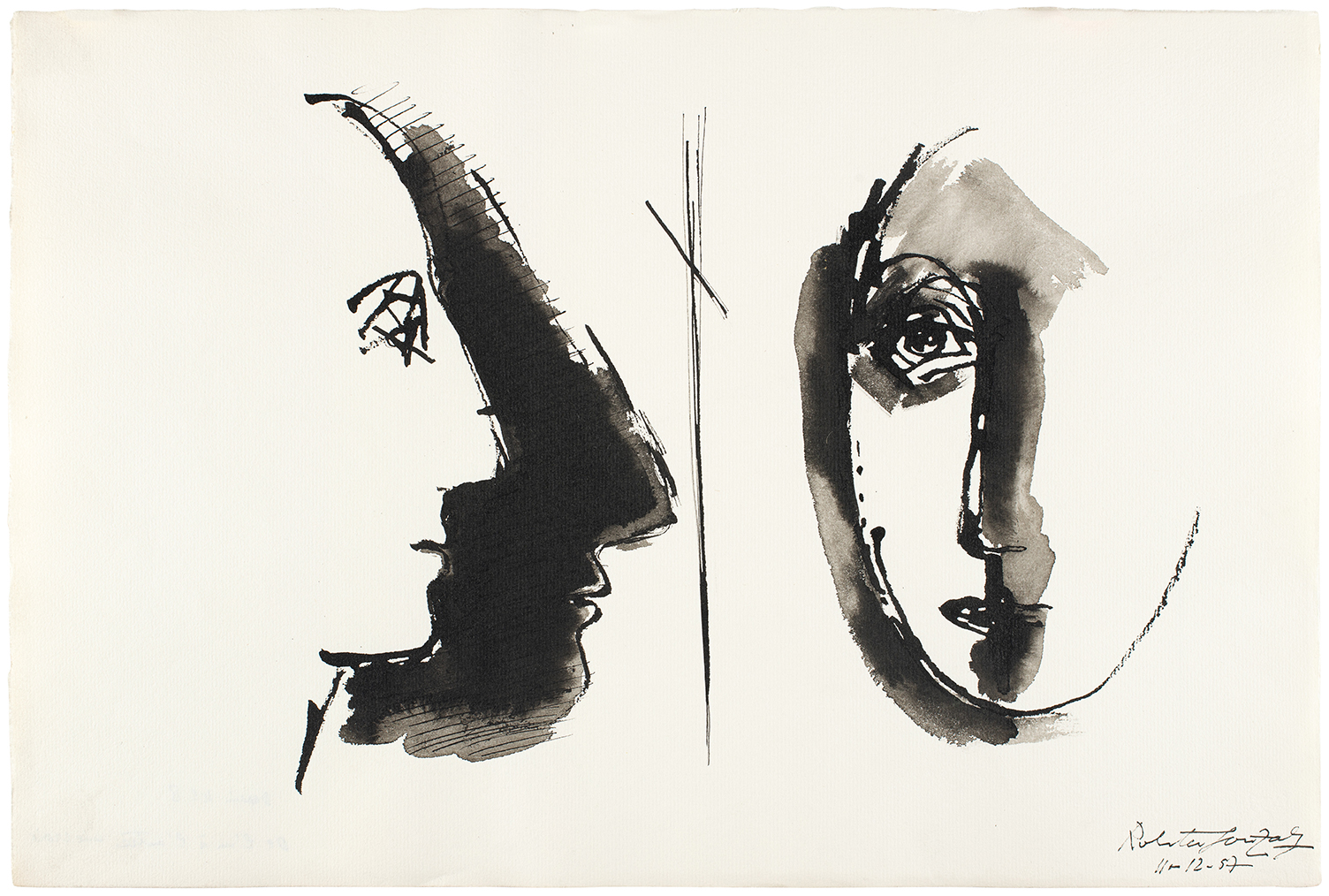
ROBERTA GONZÁLEZ (1909 -1976)
DE L’UN À L’AUTRE UNE CROIX, 1957
Ink and pen on paper
31,9 x 47,9 cm – 12 9/16 x 18 7/8 in.
Signed and dated “Roberta Gonzalez 11-12-57“ lower right
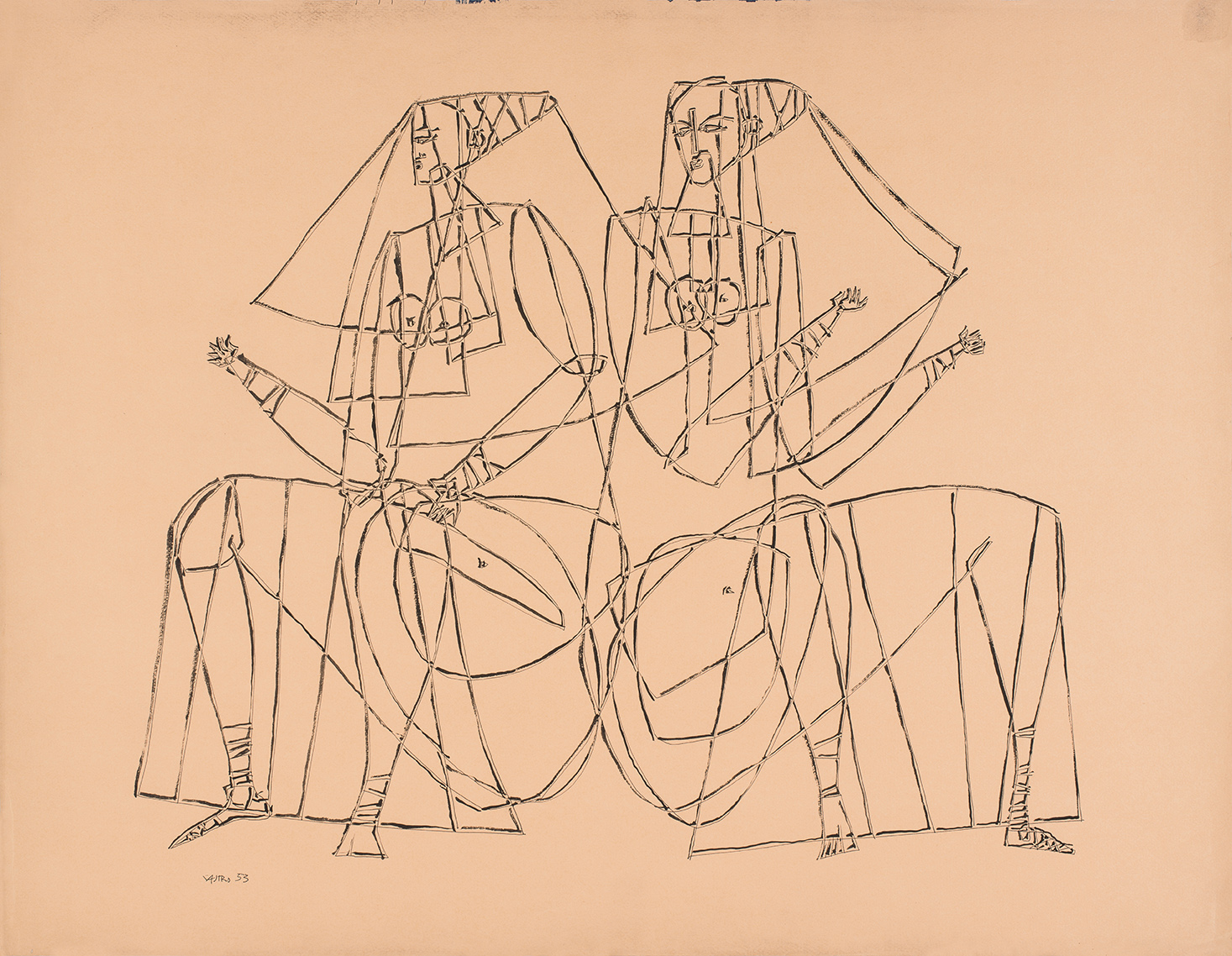
SERGIO DE CASTRO (1922 -2012)
LES PARQUES, 1953
Ink on tinted paper
50 x 65 cm – 19 11/16 x 25 9/16 in.
Signed and dated “CASTRO 53“ lower left
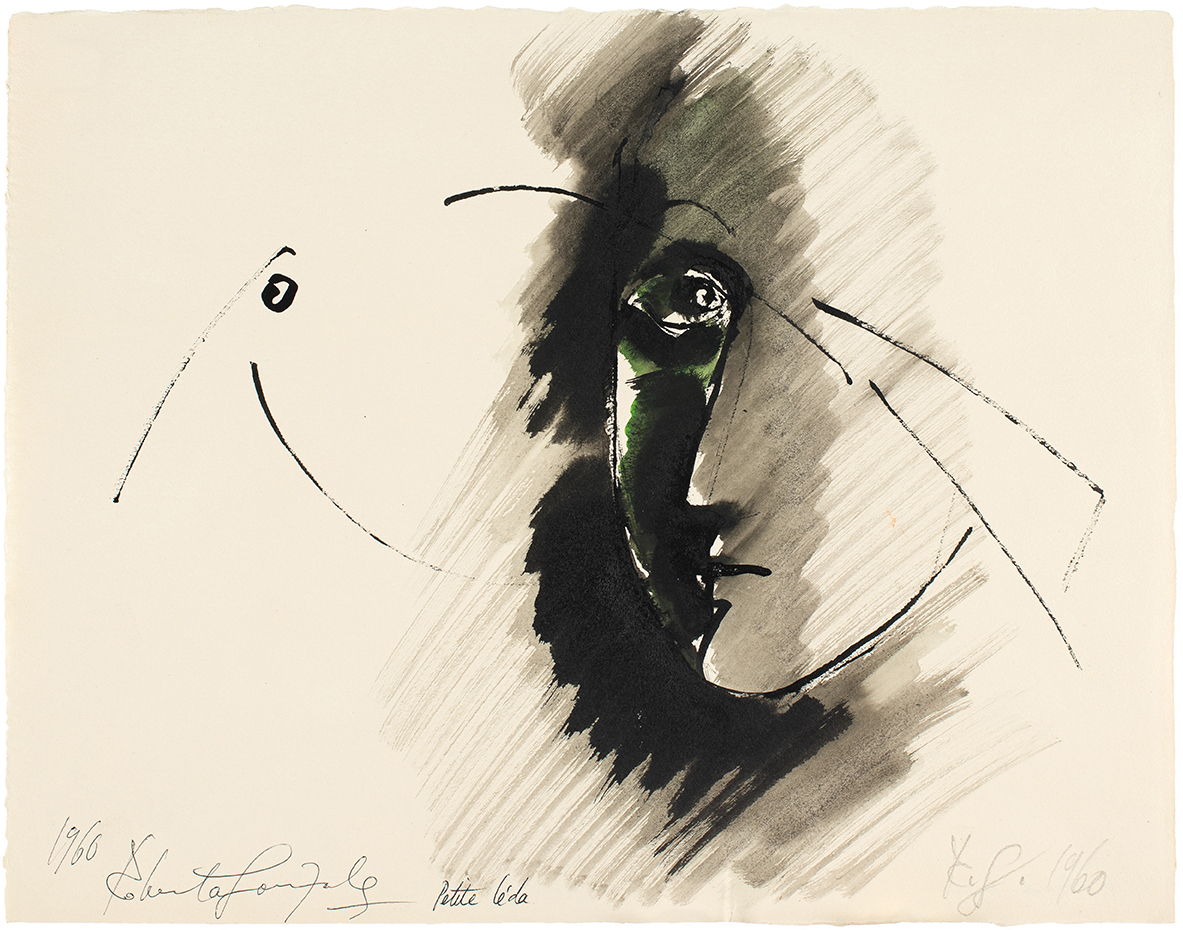
ROBERTA GONZÁLEZ (1909 -1976)
PETITE LÉDA, 1960
Ink and ink wash on paper
25,3 x 32,9 cm – 9 15/16 x 12 15/16 in.
Dated, signed and titled “1960 Roberta Gonzalez Petite Léda“ lower left
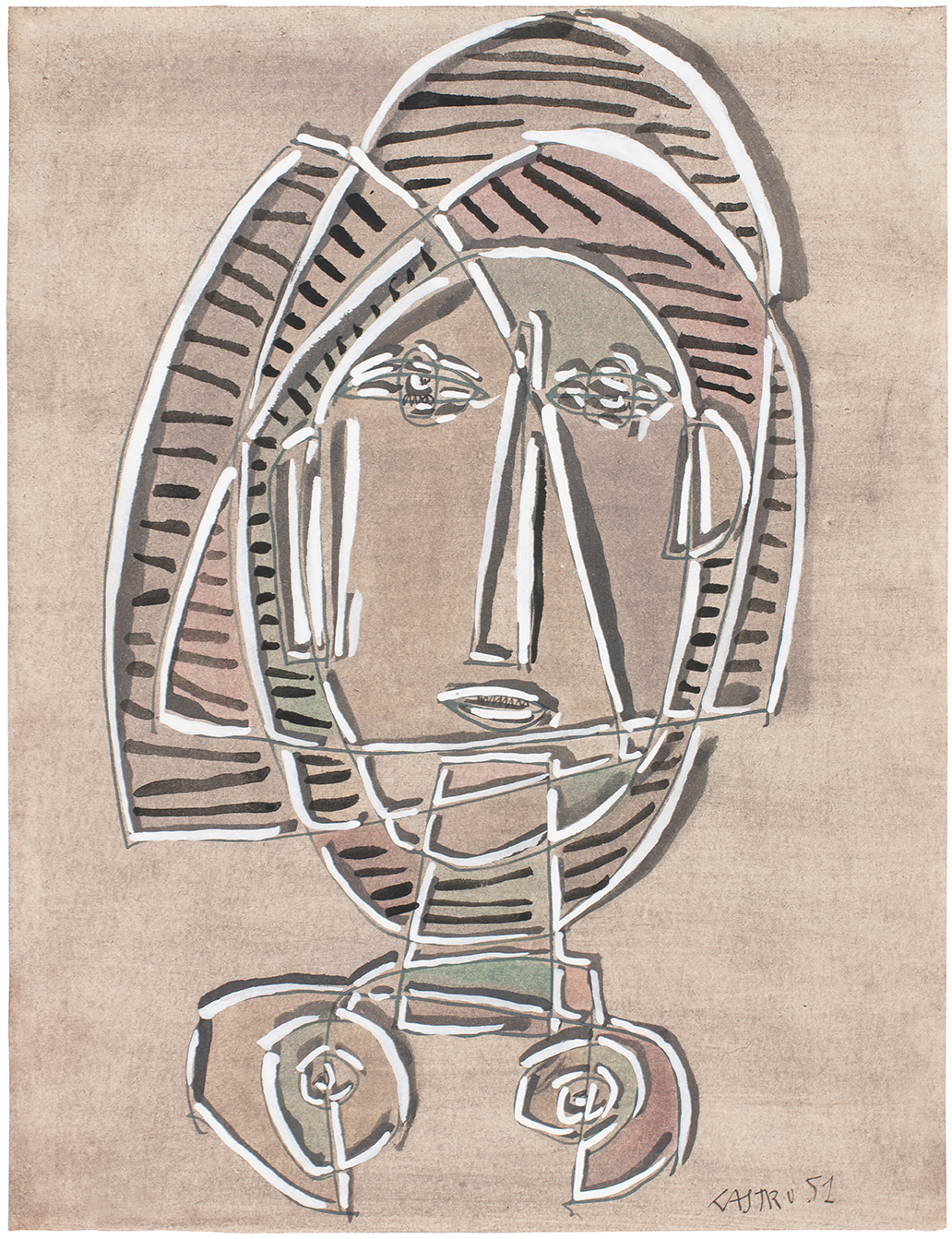
SERGIO DE CASTRO (1922 -2012)
UNTITLED, 1951
Gouache and ink on tinted paper
25,5 x 20 cm – 10 1/16 x 7 7/8 in.
Signed and dated “CASTRO 51“ lower right
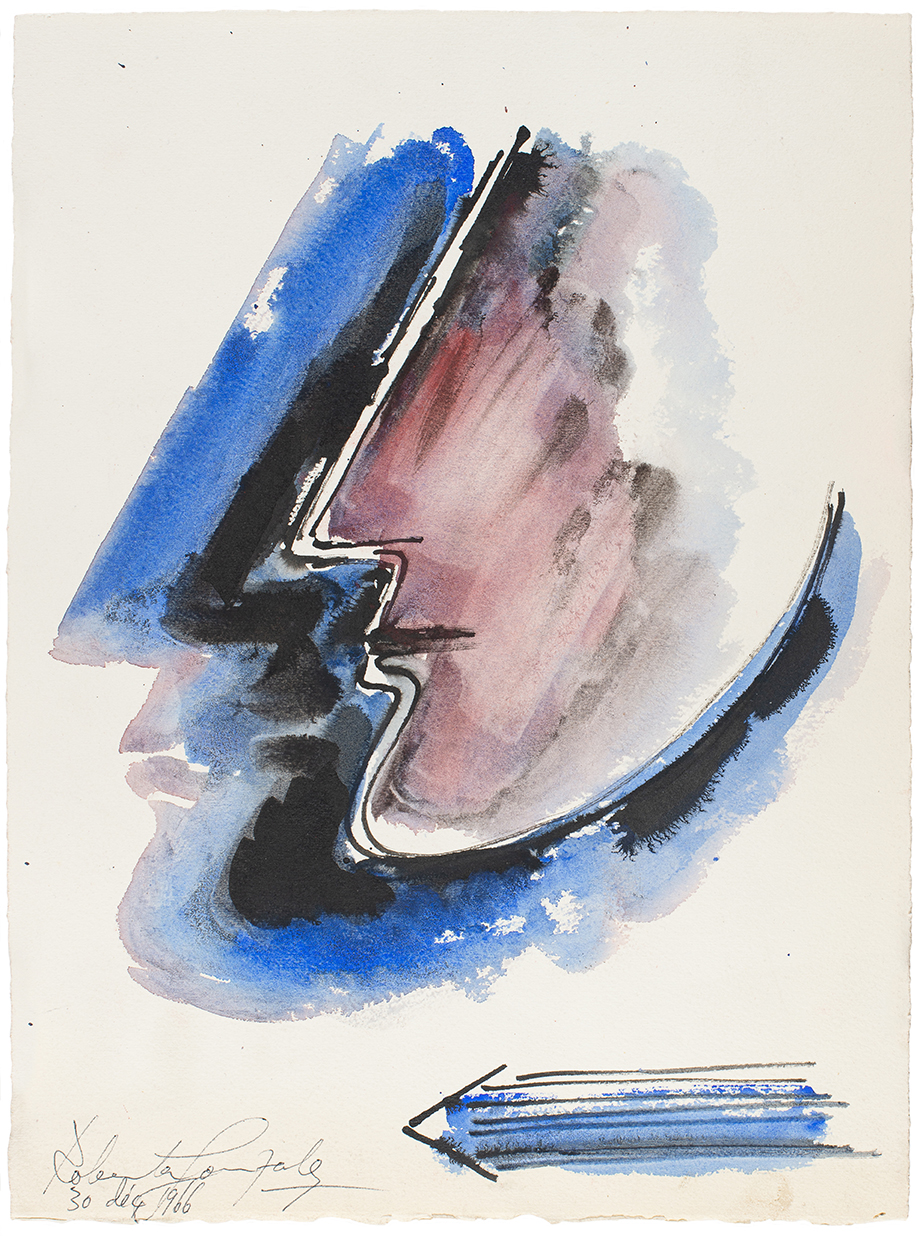
ROBERTA GONZÁLEZ (1909 -1976)
PROFILS AUX OMBRES, 1966
Gouache and ink on paper
29,1 x 21,2 cm – 11 1/2 x 8 3/8 in.
Signed and dated “Roberta Gonzalez 30 déc 1966“ lower left
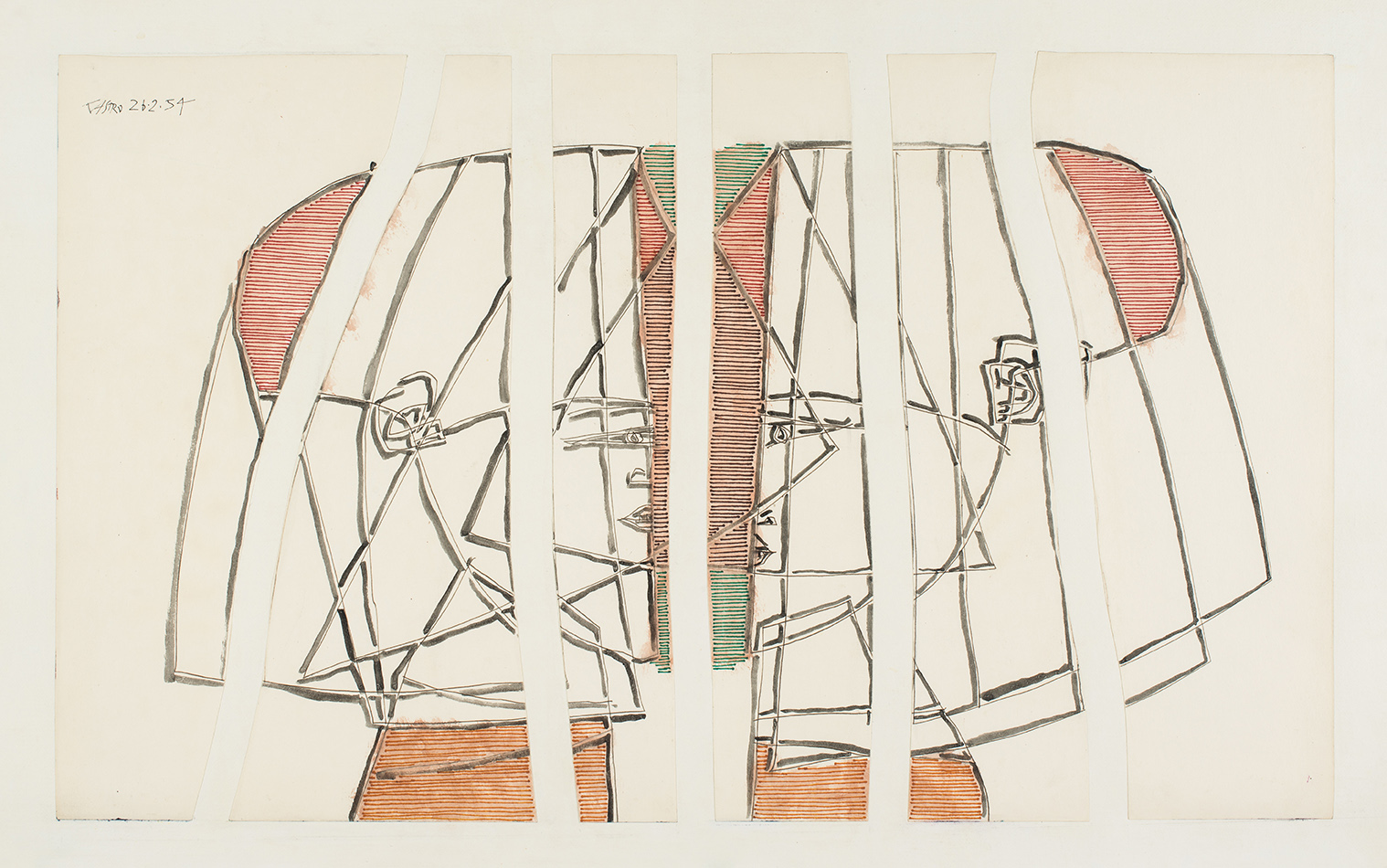
SERGIO DE CASTRO (1922 -2012)
UNTITLED, 1954
Gouache and felt pen on paper
31 x 52 cm – 12 3/16 x 20 1/2 in.
Signed and numbered “CASTRO 2b.2.54“ upper left
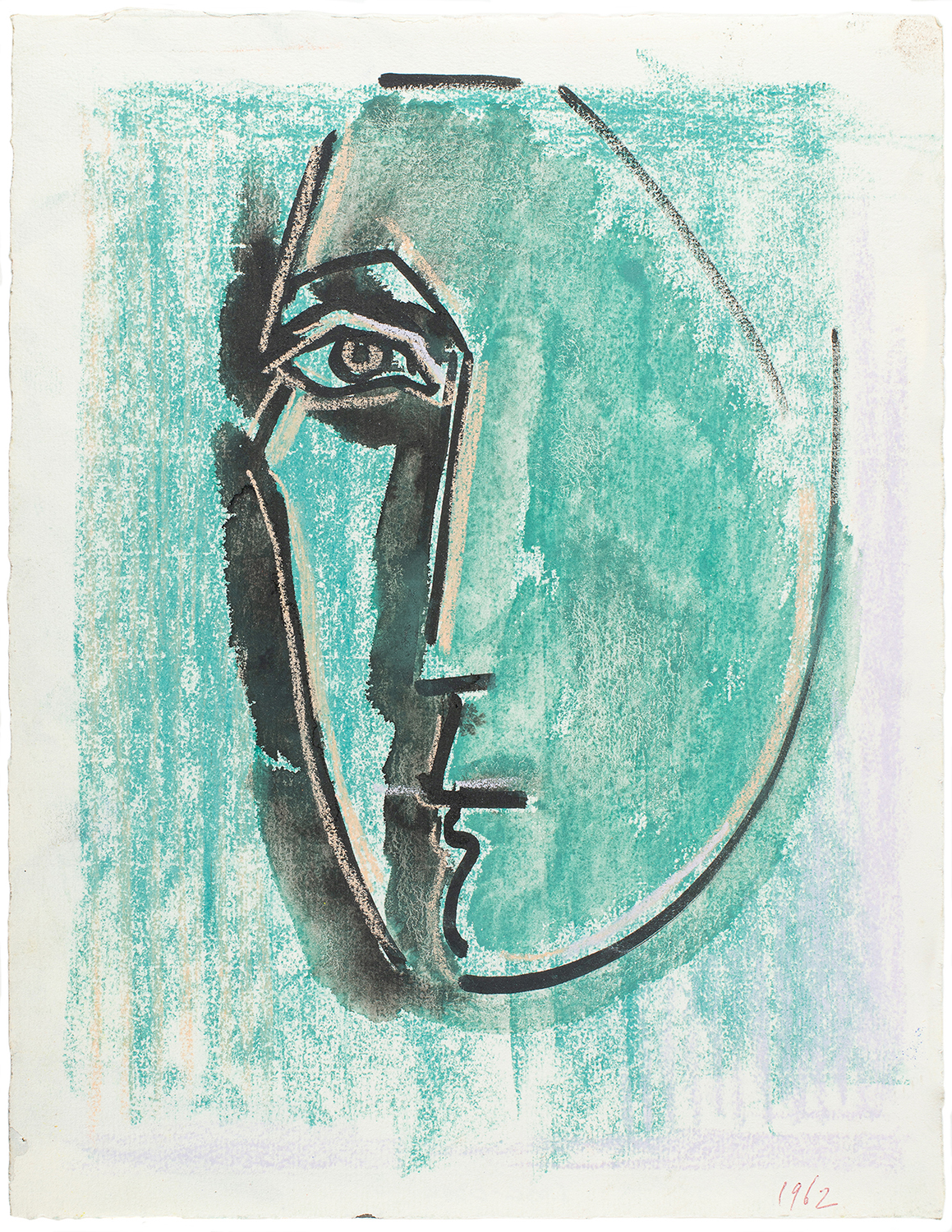
ROBERTA GONZÁLEZ (1909 -1976)
UNTITLED, 1962
Pastel and ink on paper
31,4 x 23,8 cm – 12 3/8 x 9 3/8 in.
Dated “1962“ lower right
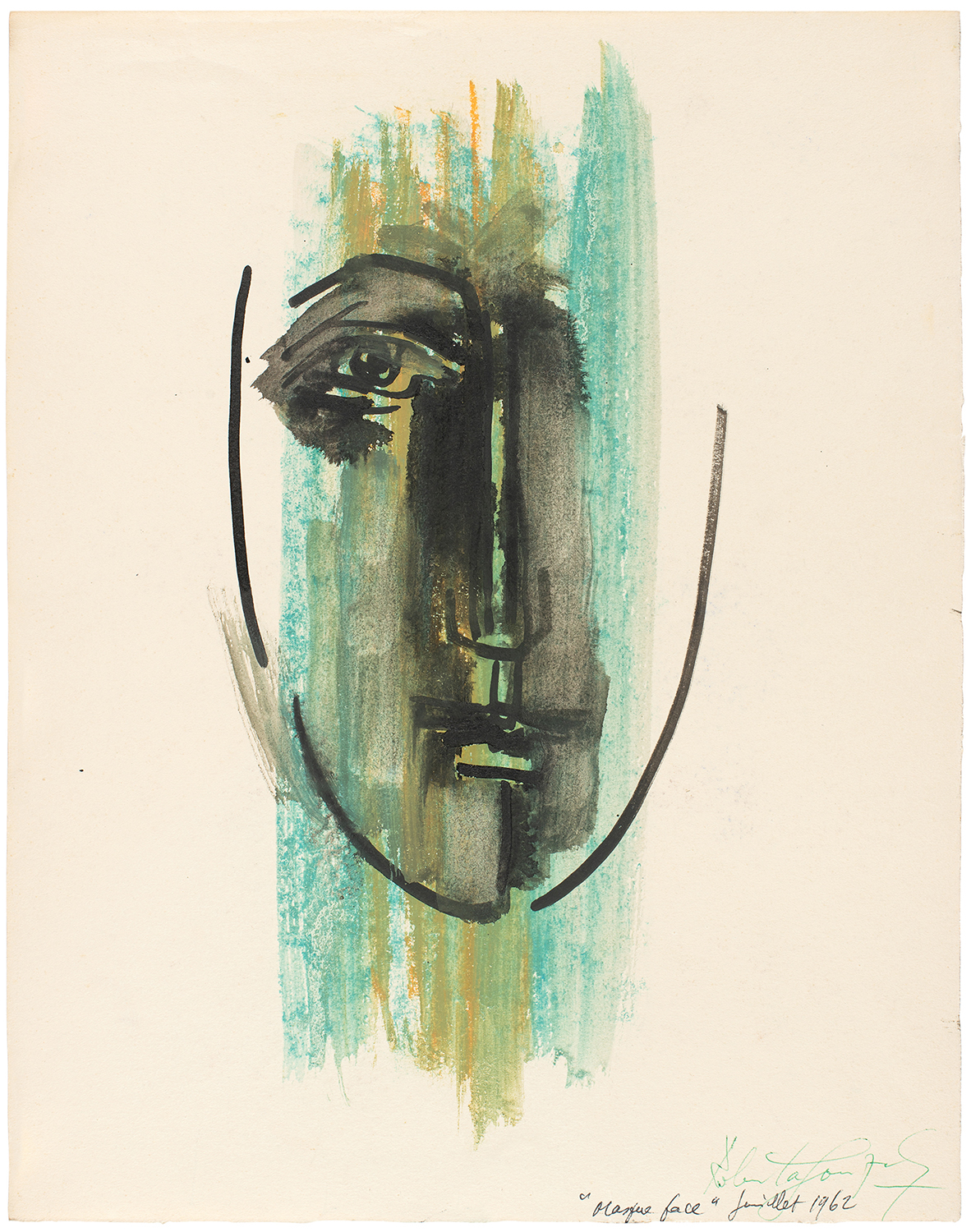
ROBERTA GONZÁLEZ (1909 -1976)
MASQUE FACE, 1962
Ink, gouache and pastel on paper
36,4 x 28,5 cm – 14 5/16 x 11 1/4 in.
Signed, titled and dated “Roberta Gonzalez Masque face Juillet 1962“ lower right
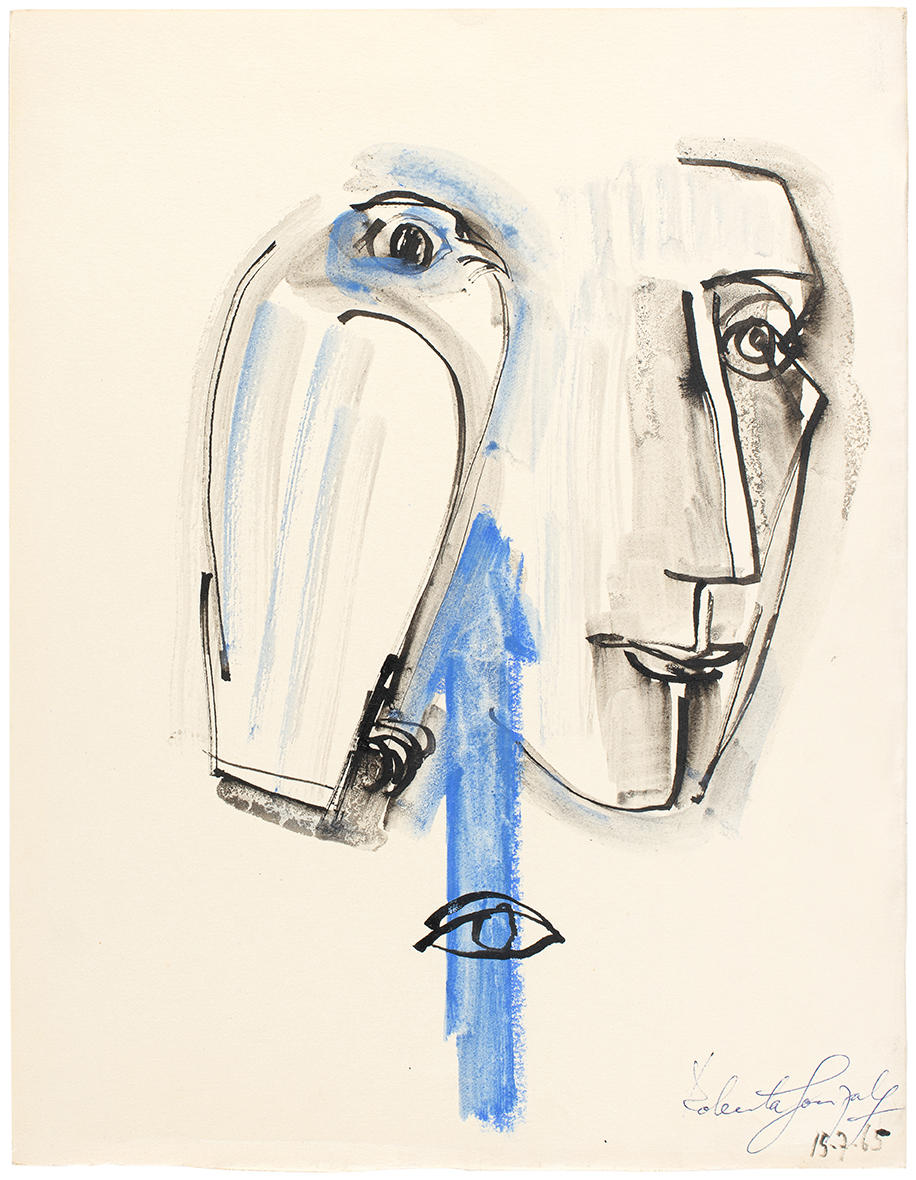
ROBERTA GONZÁLEZ (1909 -1976)
UN COUPLE, 1965
Gouache and ink on paper
32,5 x 24,8 cm – 12 13/16 x 9 3/4 in.
Signed and dated “Roberta Gonzalez 15-7-65“ lower right
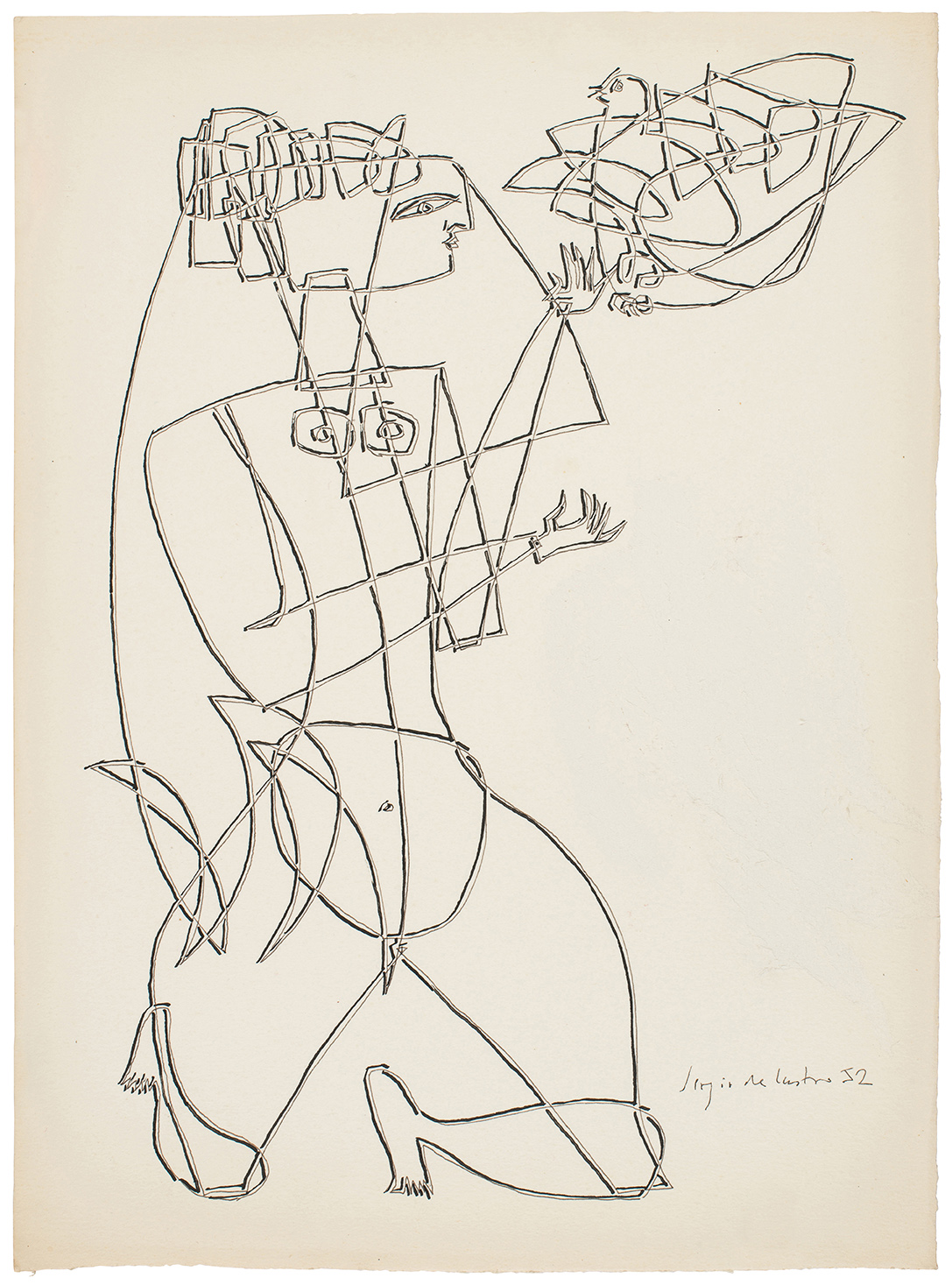
SERGIO DE CASTRO (1922 -2012)
UNTITLED, 1952
Ink on paper
36 x 26 cm – 14 3/16 x 10 1/4 in.
Signed and dated “Sergio de Castro 52“ lower right
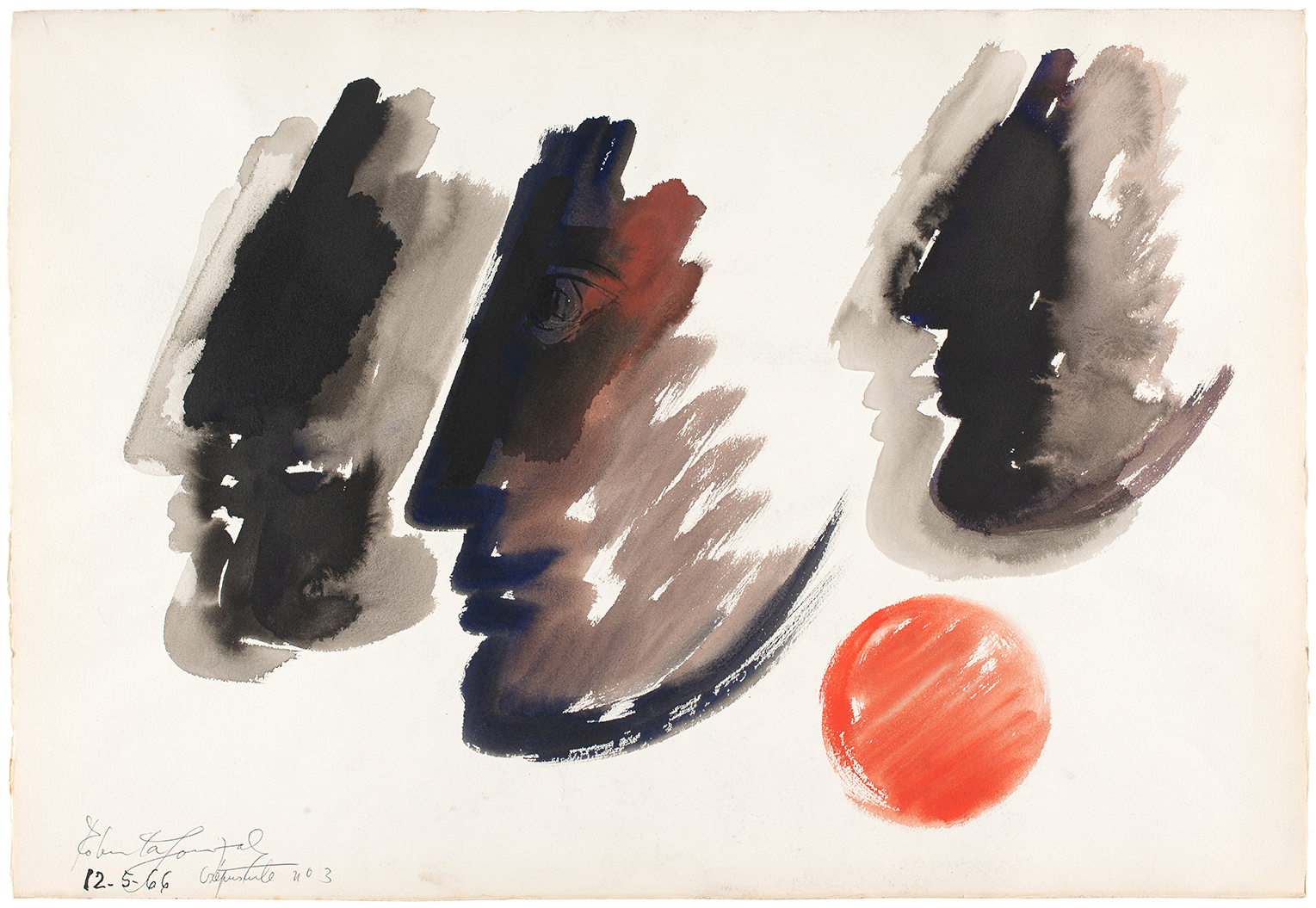
ROBERTA GONZÁLEZ (1909 -1976)
CRÉPUSCULE N°3, 1966
Ink and gouache on paper
39,5 x 58,1 cm – 15 9/16 x 22 7/8 in.
Signed, dated and titled “Roberta Gonzalez 12-5-66 Crépuscule n°3“ lower left
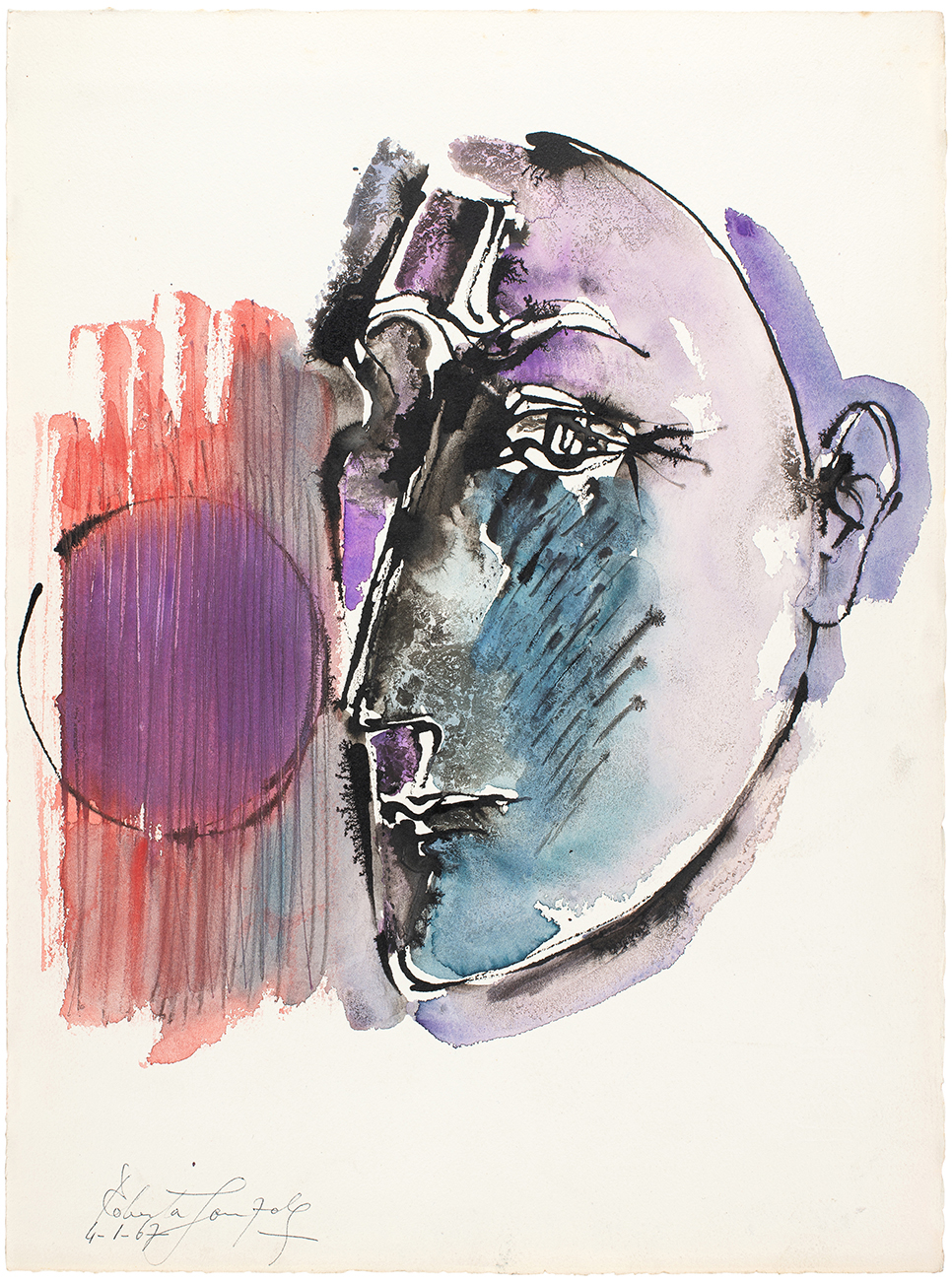
ROBERTA GONZÁLEZ (1909 -1976)
MASQUE INQUIET AU SOLEIL, 1967
Gouache and ink on paper
39,4 x 29 cm – 15 1/2 x 11 7/16 in.
Signed and dated “Roberta Gonzalez 4-1-67“ lower left
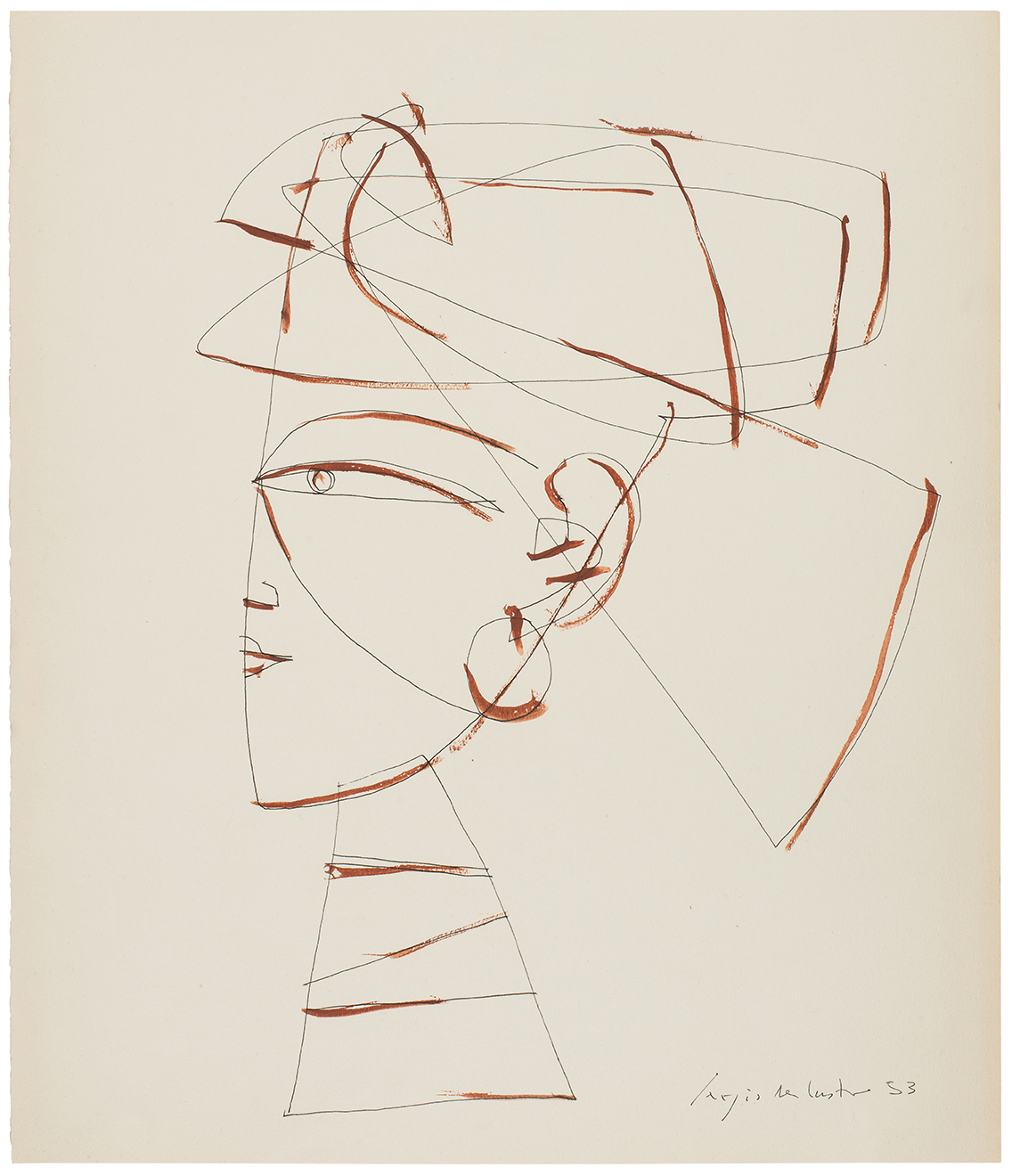
SERGIO DE CASTRO (1922 -2012)
UNTITLED, 1951
Gouache and ink on paper
42 x 36 cm – 16 9/16 x 14 3/16 in.
Signed and dated “Sergio de Castro 53“ lower right

ROBERTA GONZÁLEZ (1909 -1976)
VISAGE ET SES OMBRES, 1967
Gouache, ink and pen on paper
50 x 32,7 cm – 19 11/16 x 12 7/8 in.
Signed and dated “Roberta Gonzalez 1-9-67“ lower right
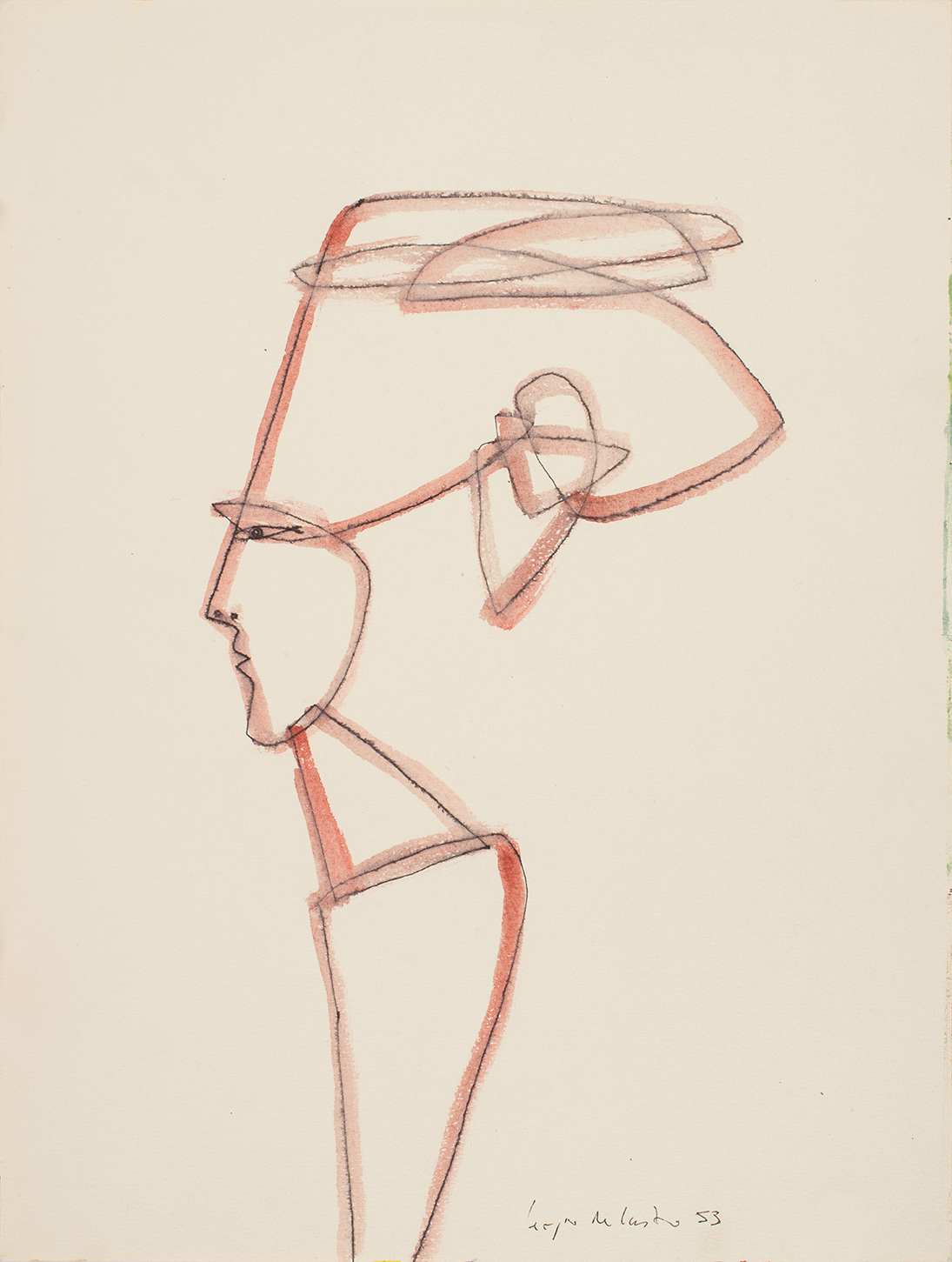
SERGIO DE CASTRO (1922 -2012)
UNTITLED, 1953
Ink and gouache on paper
35 x 26 cm – 13 3/4 x 10 1/4 in.
Signed and dated “Sergio de Castro 53“ lower right
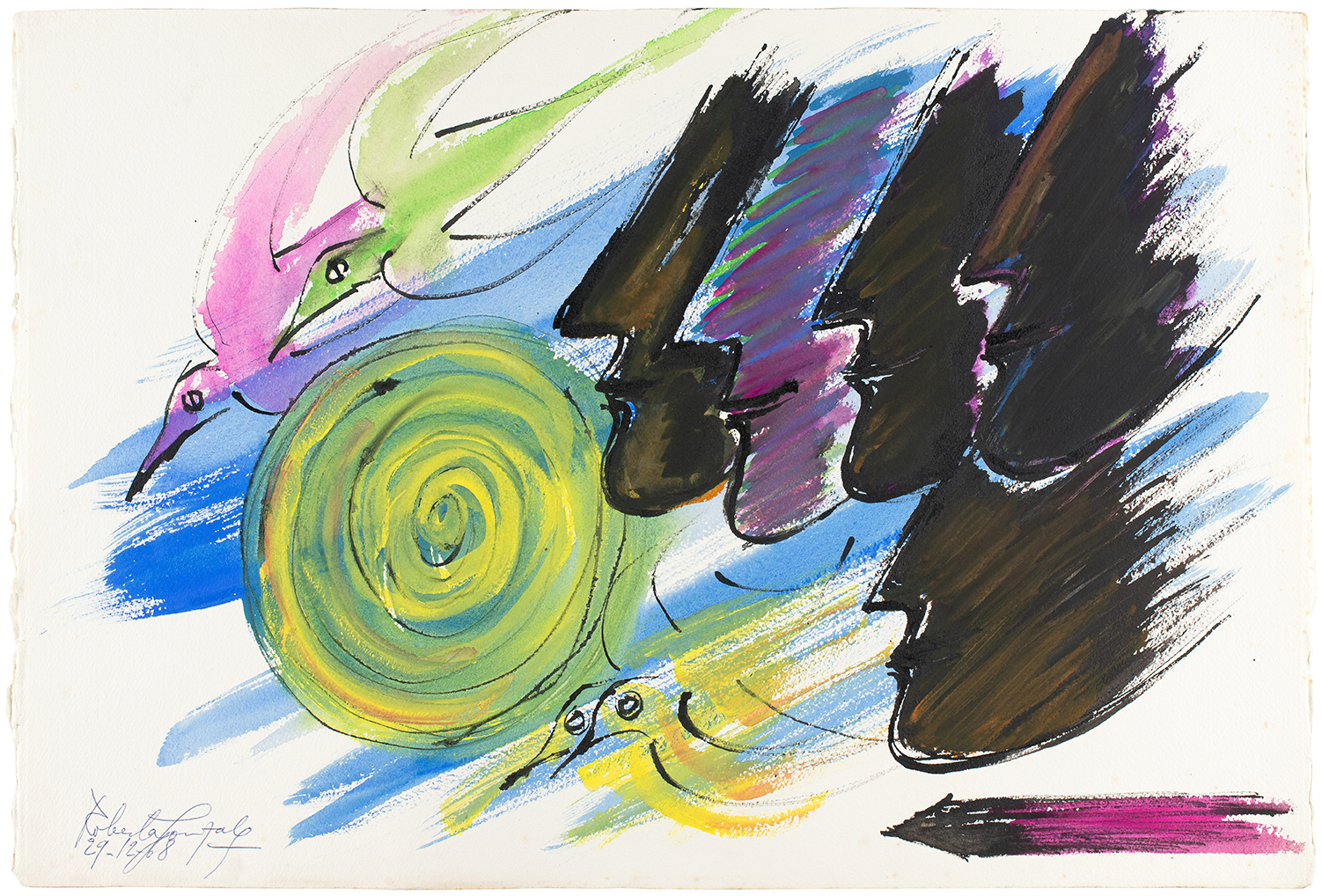
ROBERTA GONZÁLEZ (1909 -1976)
PROFILS, SOLEIL ET OISEAUX, 1968
Gouache and ink on paper
38 x 56 cm – 14 15/16 x 22 1/16 in.
Signed and dated “Roberta Gonzalez 29-12-68“ lower left
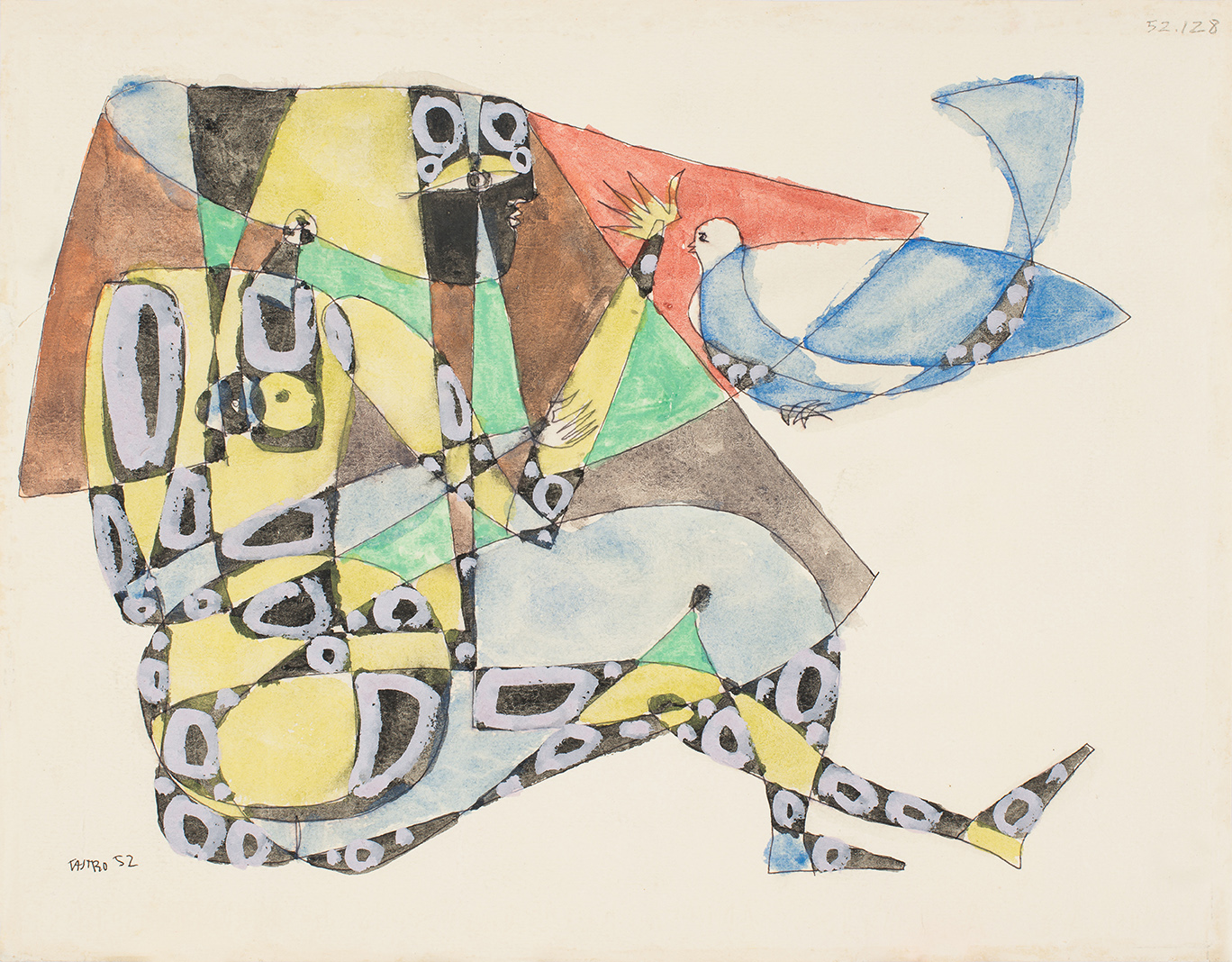
SERGIO DE CASTRO (1922 -2012)
MUJER Y PALOMA, 1952
Gouache and ink on paper
24 x 31 cm – 9 7/16 x 12 3/16 in.
Signed and dated “CASTRO 52“ lower left

ROBERTA GONZÁLEZ (1909 -1976)
IL FAUT BIEN Y ALLER, 1968
Gouache and ink on paper
38 x 56,5 cm – 14 15/16 x 22 1/4 in.
Signed and dated “Roberta Gonzalez 28.12.1968“ lower right

SERGIO DE CASTRO (1922 -2012)
UNTITLED, 1954
Ink on paper
27 x 20,5 cm – 10 5/8 x 8 1/16 in.
Signed and dated “CASTRO 54“ lower left
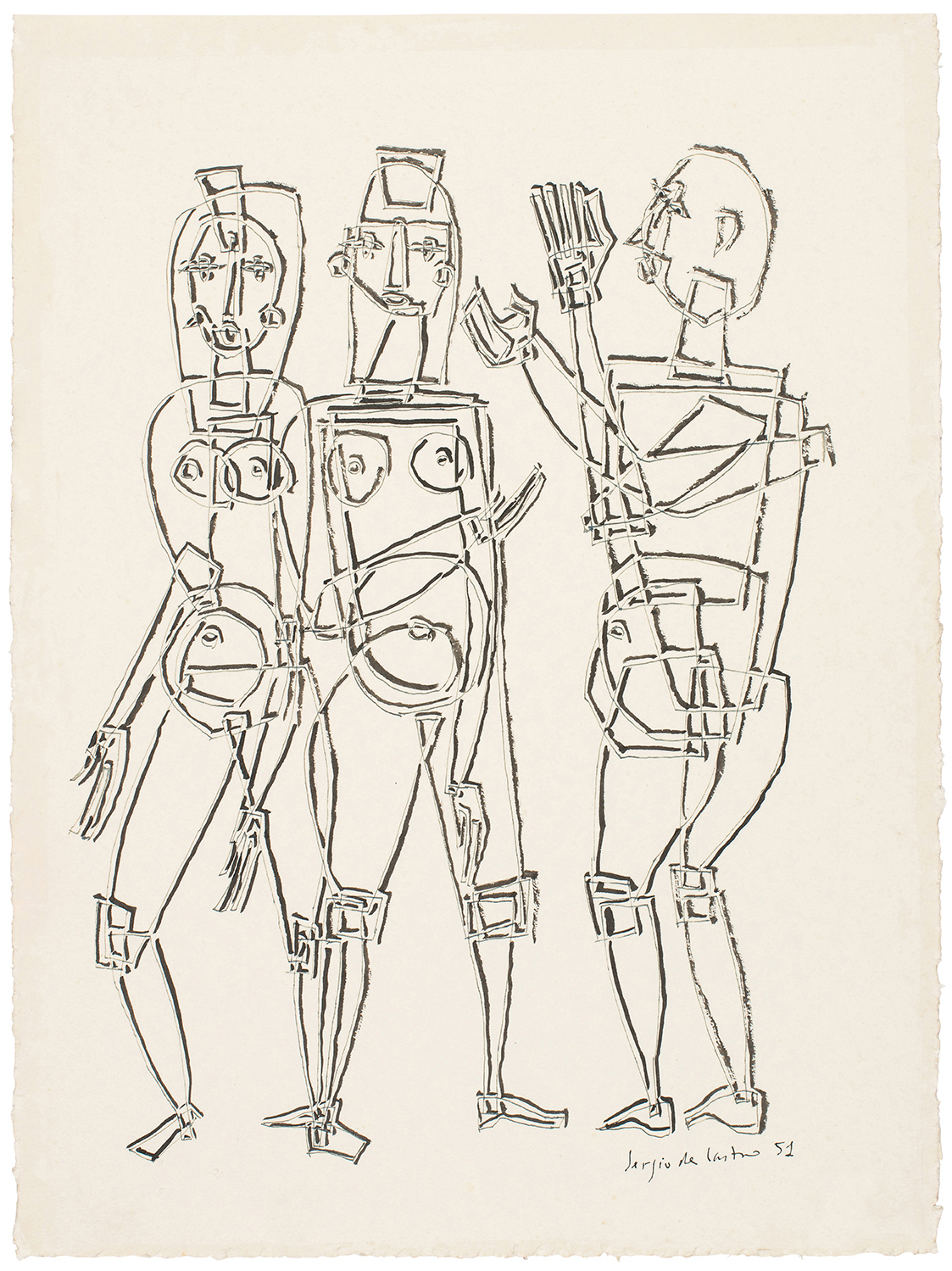
SERGIO DE CASTRO (1922 -2012)
UNTITLED, 1951
Ink on paper
34 x 25,5 cm – 13 3/8 x 10 1/16 in.
Signed and dated “Sergio de Castro 51“ lower right
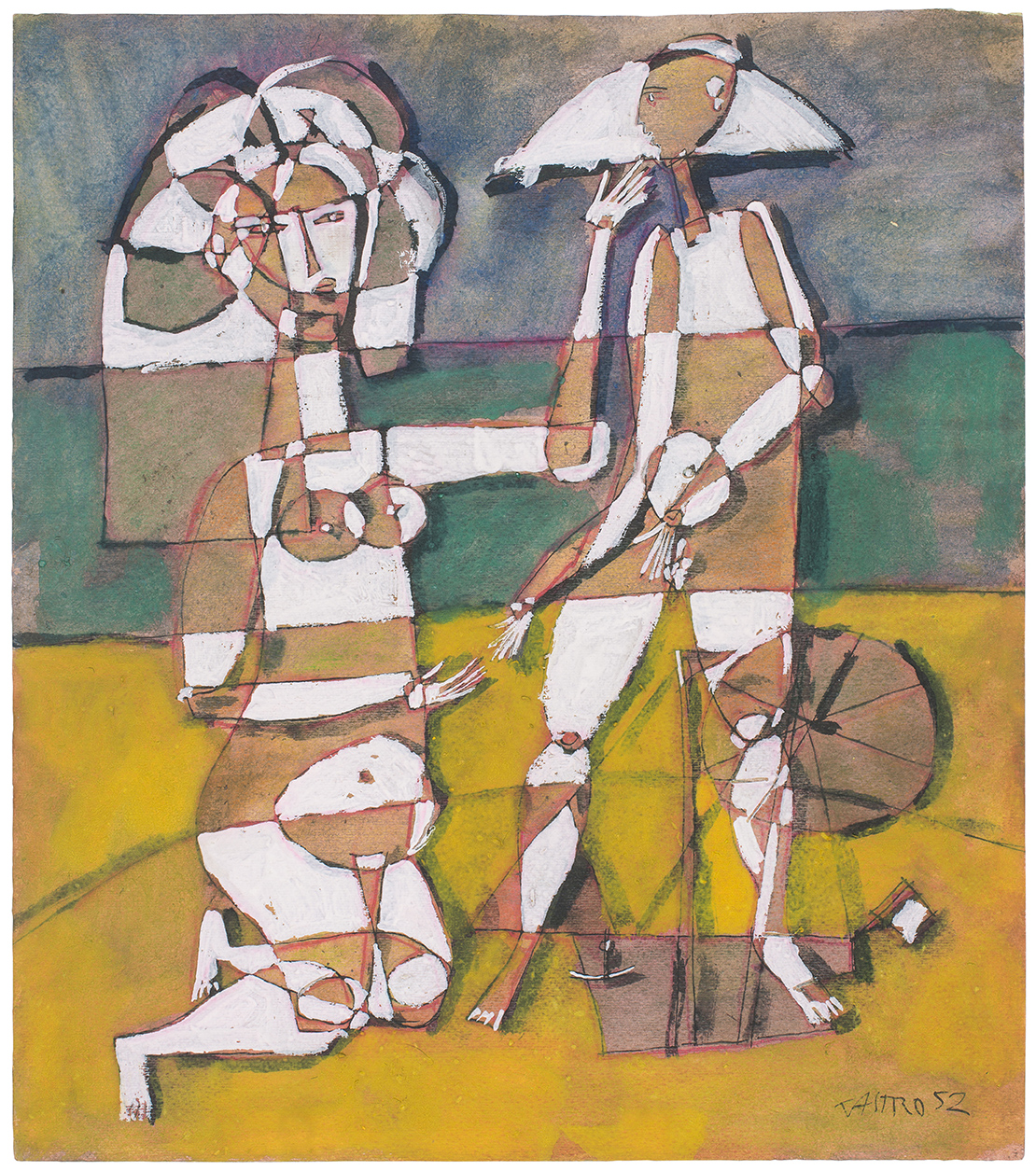
SERGIO DE CASTRO (1922 -2012)
UNTITLED, 1952
Gouache and ink on paper
36 x 32 cm – 14 3/16 x 12 5/8 in.
Signed and dated “CASTRO 52“ lower right
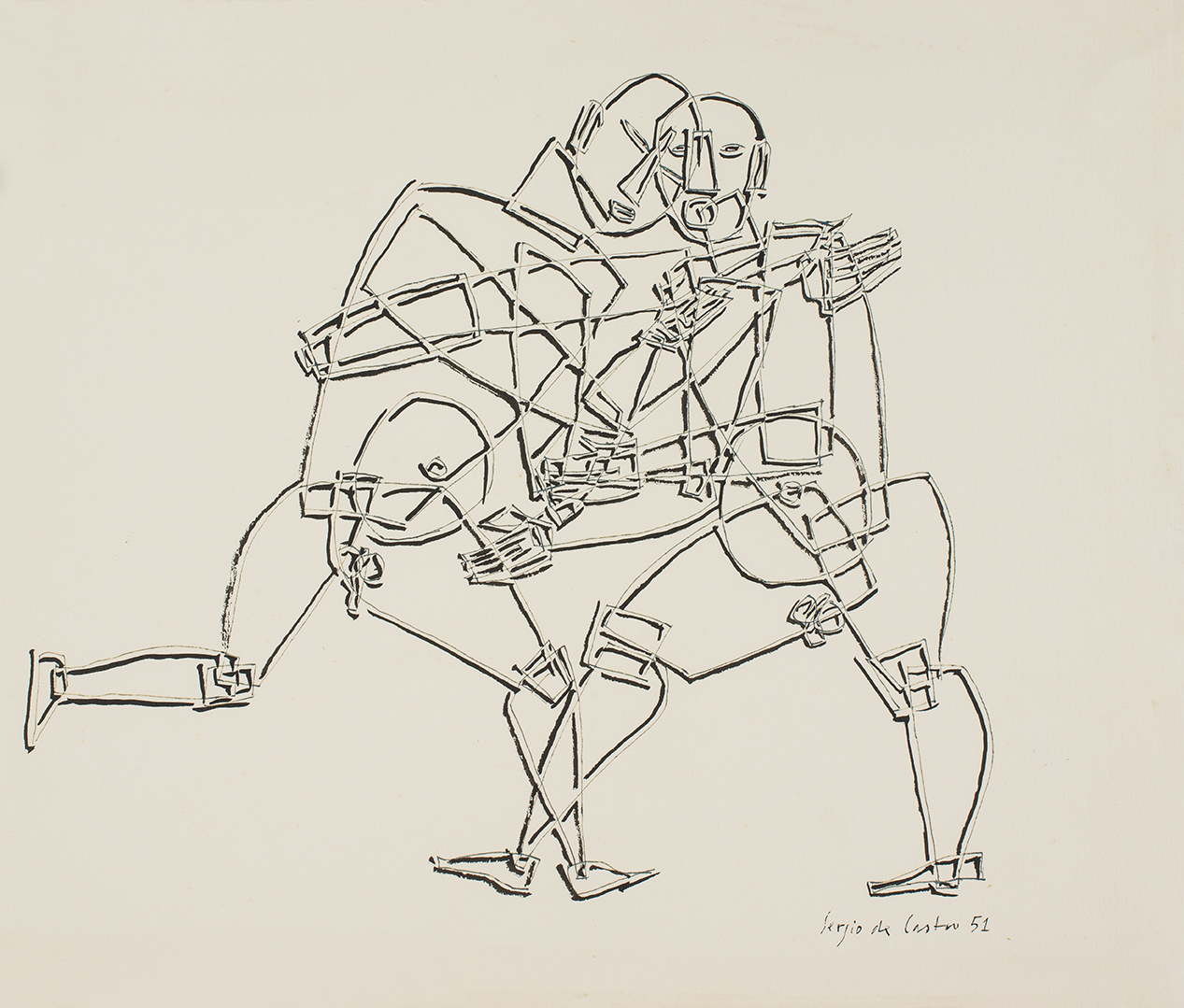
SERGIO DE CASTRO (1922 -2012)
LUCHADORES, 1951
Ink on paper
26,5 x 30,5 cm – 10 7/16 x 12 in.
Signed and dated “Sergio de Castro 51“ lower right
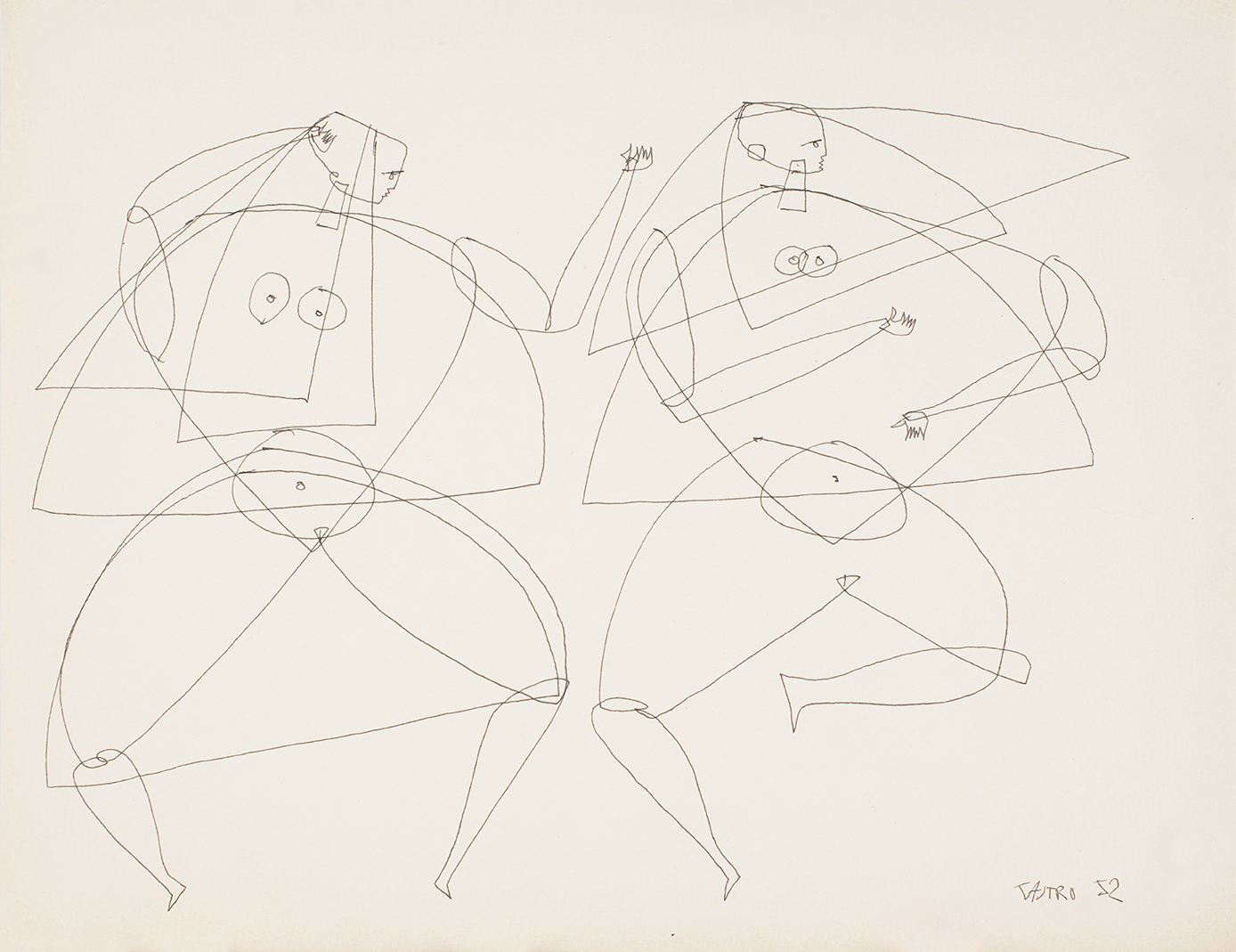
SERGIO DE CASTRO (1922 -2012)
UNTITLED, 1952
Ink on paper
26,5 x 30,5 cm – 10 7/16 x 12 in.
Signed and dated “Sergio de Castro 51“ lower right
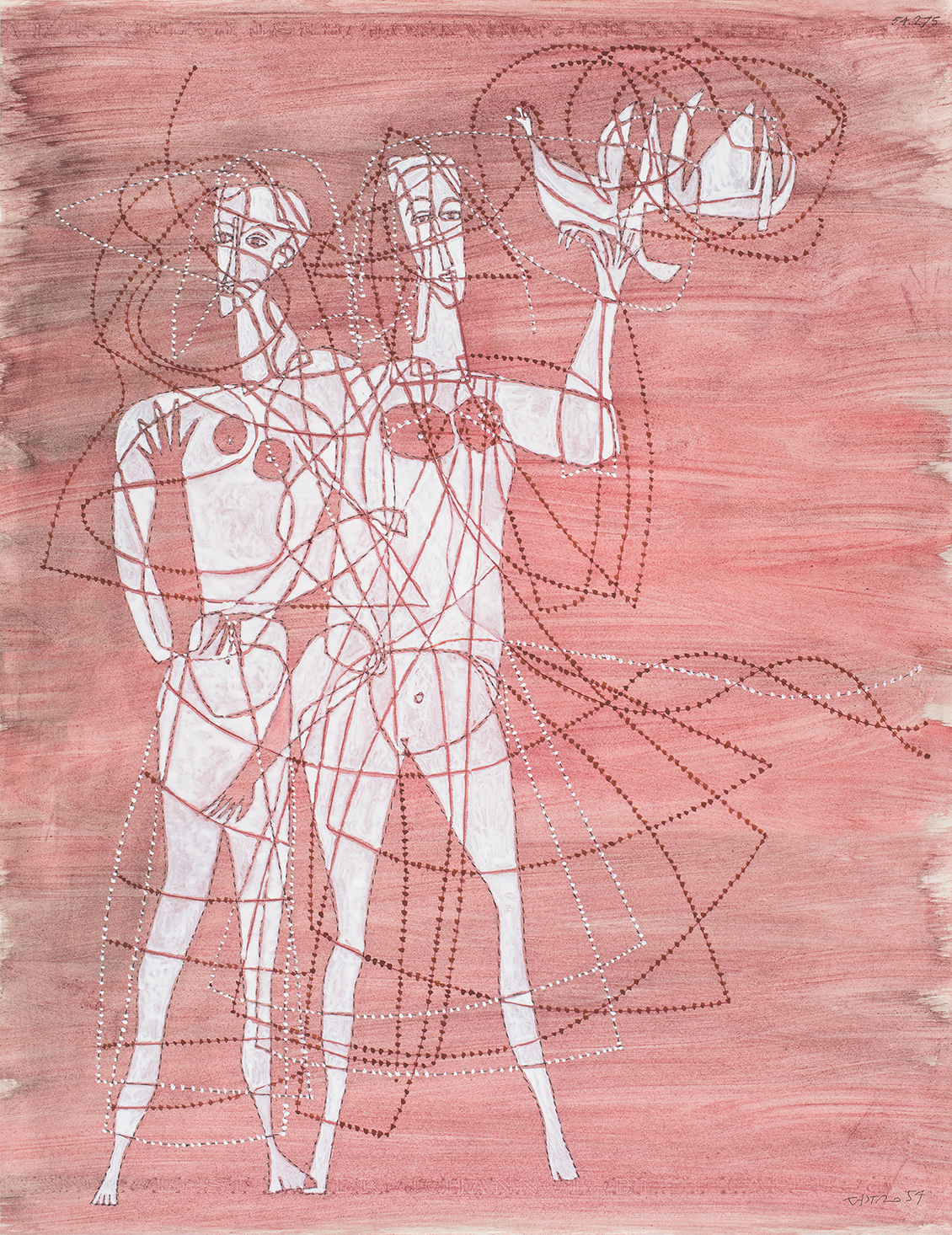
SERGIO DE CASTRO (1922 -2012)
UNTITLED, 1954
Gouache and pencil on paper
55,5 x 42,5 cm – 21 7/8 x 16 3/4 in.
Signed and dated “CASTRO 54“ lower right
ROBERTA GONZÁLEZ
(1909-1976)
ROBERTA GONZÁLEZ’S EARLY LIFE AND ARTISTIC TRAINING
Roberta González, the only daughter of the Catalan sculptor Julio González (1876– 1942), was born in Paris on 13 September 1909. Roberta grew up within the French capital’s Catalan community, where art played a central role in her upbringing: in addition to her father, a sculptor, Roberta’s uncle Joan González (1868–1908) was known for his drawings, and her aunts, Lola and Pilar, worked in fashion and crafts. Pablo Picasso, a long-standing friend of Julio’s, regularly visited the family home and is said to have encouraged the young Roberta to try her hand at drawing. Roberta González naturally pursued the family’s artistic vocation, supported by her father, who treasured her childhood drawings and told her: “You will be a painter, and you will accomplish as a painter what neither your uncle nor I have been able to express in painting.” A drawing by Roberta from 1918 was even published in 1924 in the journal Les Feuilles libres: lettres et arts to illustrate “Les Enfants” by André Lhote. The attention and encouragement Roberta received from her father were all the more important as she was abandoned at an early age by her mother Louise “Jeanne” Berton. “My aunts are my real mothers,” Roberta wrote in her notebooks. “The other one is completely indifferent to me.”
From 1927, Roberta González attended courses at the Académie Colarossi, a Paris art school founded in 1870 by the Italian sculptor Filippo Colarossi. This co-educational academy allowed female students to paint and sculpt from nude male models. Camille Claudel, for example, was one of the best-known artists to have attended the academy. Renowned for its life sculpture classes, the school attracted students from around the world. In 1907, the academy appointed its first female professor, New Zealand artist Frances Hodgkins, thus confirming its progressive spirit.
WAR AND EXILE FOR THE GONZÁLEZ-HARTUNG FAMILY
In the 1930s, Roberta adopted an artistic style influenced by Cubism and Surrealism. When the Spanish Civil War broke out in 1936, Picasso, Julio and Roberta González expressed their support for Republican Spain through their work. Julio González and Pablo Picasso jointly represented democratic Spain at the Exposition Universelle in Paris in 1937. In support of the Spanish people, Picasso presented his masterpiece Guernica, and González exhibited his iron sculpture La Montserrat. For her part, Roberta González painted mother-and-child scenes and peasant women with angular features, as tributes to Catalan women.
In 1936, Roberta’s only iron sculpture was exhibited alongside her painting Femme assise in the exhibition L’art espagnol contemporain at the Musée des Écoles Étrangères contemporaines (the future Musée du Jeu de Paume). The sculpture was acquired by the French state. Although born in France, Roberta was from the outset considered part of the Franco-Spanish art scene.
In 1937, Hans Hartung, an abstract painter, was introduced to Julio González, whose work he admired. The sculptor welcomed him to his studio in Arcueil and introduced him to his signature technique: autogenous welding. This technique allowed for the fusion of metal parts of the same kind, without the need for any external material. While the two artists shared a mutual respect for each other, their creative visions differed: Hans Hartung was an advocate of pure abstraction, while Julio González defended the absolute necessity of taking nature as a starting point. Roberta González and Hans Hartung grew close and fell in love. Roberta recalled: “I first loved the artwork and then the man; perhaps I even loved the man because I loved his work.” Roberta González and Hans Hartung exhibited their work together in 1939 at the Galerie Henriette Gomes in Paris. They married on 22 July 1939, but their happily ever after was interrupted by the outbreak of the Second World War. Despite his opposition to the Nazi regime, Hans Hartung was arrested and interned. He was released on the 26th of December, after which he enlisted in the French Foreign Legion and was sent to North Africa. After the signing of the armistice, Hans Hartung was demobilized, leaving the army on 8 September 1940. The González-Hartung family left occupied Paris, taking refuge in Lasbouygues in the Lot region. Despite very difficult living conditions, Roberta, Julio González and Hans Hartung continued to create work. Roberta produced portraits of her family, and deformed female figures, bearing the marks of the violence of war.
In 1941, Julio González and his second wife, Marie-Thérèse Roux, returned to Paris so that Julio could resume his sculpting work. Julio González died suddenly in March 1942, which was a devastating blow for Roberta, who was unable to be by her father’s side or attend his funeral. Furthermore, her husband Hartung had to flee and left the Lot region in 1943 to escape the Nazi invasion. The couple would not be reunited until after the end of the war.
THE POST-WAR PERIOD AND A SYNTHESIS OF FIGURATION AND ABSTRACTION
In 1945, the Hartung-González couple returned to Paris. Roberta took to painting melancholy women, a reflection of her dark war years. Cubist angles gave way to curves as she asserted herself as an independent artist, attempting to synthesize figuration and abstraction. Her iconographic vocabulary took shape, defined by women, masks, birds, suns, arrows, eyes… and geometric planes. She wrote: “The problems posed by abstraction haunt me in the same way as those posed by figuration. The most difficult thing is to establish a kind of synthesis of the two forms of expression. I’m looking for a kind of balance.”
Roberta González had her first solo exhibitions in some of the most prestigious galleries in Paris, including the Galerie Jeanne Bucher in 1948, the Galerie Colette Allendy in 1951, the Galerie Nina Dausset in 1954, and the Galerie Paul Mary in 1955. She also participated in Parisian salons and group shows in France and abroad. Roberta González and Hans Hartung separated in 1952.
In addition to her own work as an artist, Roberta also had to champion and promote her father’s work. She organised numerous exhibitions and had pieces of his work entered into prestigious collections. Thanks to her efforts, Julio González is today recognized as a great pioneer of modern sculpture. Like many artists’ heirs, Roberta González often put her own work aside in favour of recognition of her father’s work.
From 1960 onwards, Roberta González lived between the Paris region and her home and studio in Bormes-les-Mimosas (in the Var region) – a modernist villa for which she drew up the plans herself. Her painting style became increasingly colourful and dynamic. The principle of duality – between figuration and abstraction, immobility and movement, shadow and light – took on great importance in her compositions. Her works from this period were poetic and joyful. The first exhibition of the family’s works took place in 1965: Les Trois González was shown at the Galerie de France in Paris and then in Los Angeles. In 1969, Roberta was honoured for her numerous donations of her father’s works; she was named a Major Donor to the National Museums of France. Two years later, she was awarded the title of Chevalier of the Ordre des Arts et Lettres. In 1971, Catherine Valogne wrote a biography of the artist, which was published by Le Musée de Poche. Roberta González passed away on 10 July 1976.
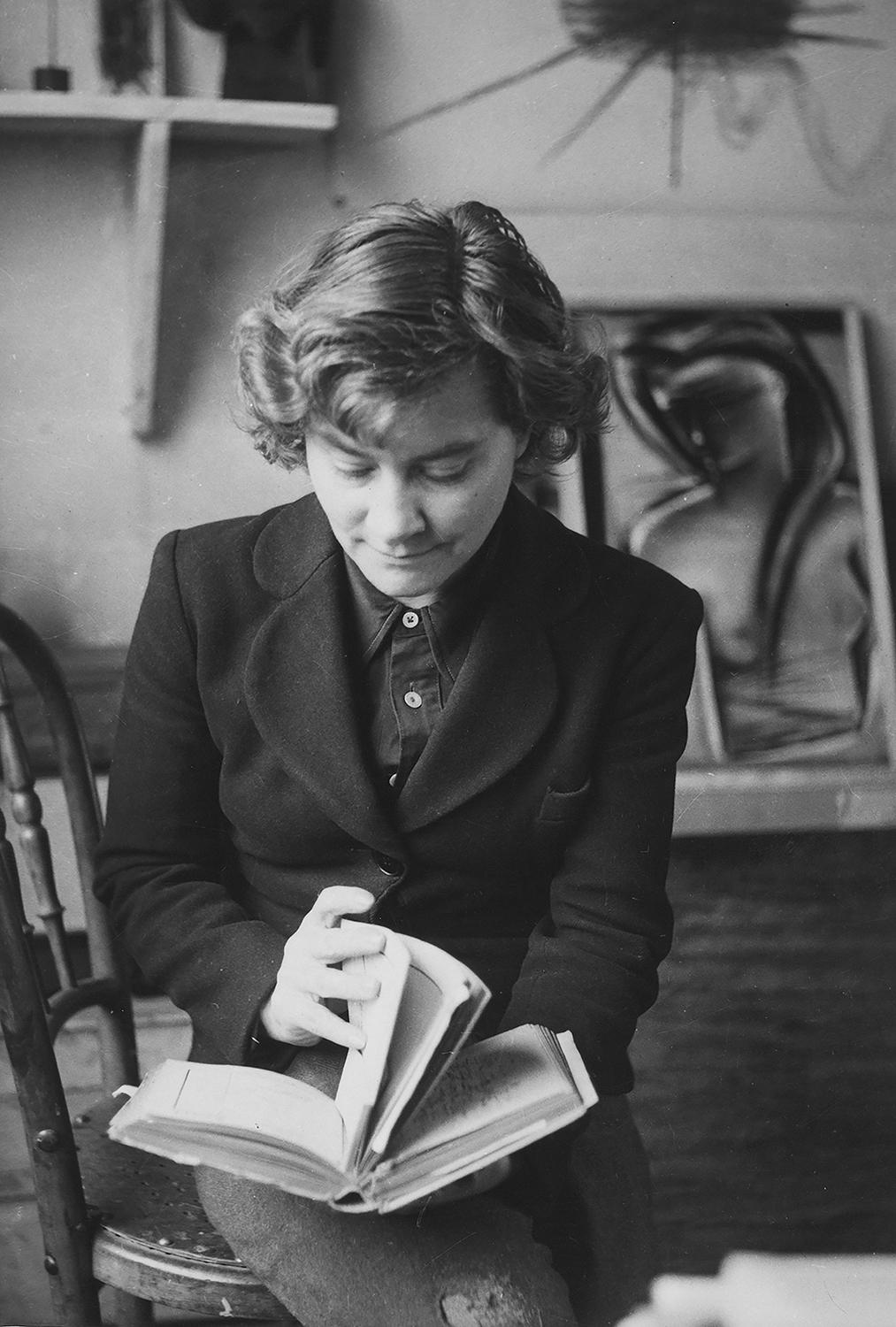
Roberta González, Arcueil, France, c. 1949
Selected public collections
Allemagne
Nürtingen, Sammlung Domnick
Espagne
Alicante, Museo de Arte Contemporáneo de Alicante – MACA>
Barcelone, Musée national d’art de Catalogne
Valence, Institut valencien d’art moderne
France
Antibes, Fondation Hans Hartung et Anna-Eva Bergman
Nantes, Musée des arts de Nantes
Paris, Musée national d’art moderne, Centre Pompidou
Paris, González Administration
Paris, Centre national des arts plastiques
Pau, Musée des Beaux-Arts
Roubaix, La Piscine
Saint-Paul-de-Vence, Fondation Maeght
Vézelay, Musée Zervos – Maison Romain-Rolland
États-Unis
Wellesley, MA, Davis Museum at Wellesley College
Selected exhibitions
Exposition collective, Galerie Castelucho, Paris, France, 1933
Salon des Surindépendants, Paris, France, 1934, 1951
Exposition collective, L’art espagnol contemporain, Musée des Écoles étrangères contemporaines, Jeu de Paume, Paris, France, 1936
Exposition collective, Dessins et pastels par Roberta González et Hans Hartung, Galerie Henriette, Paris, France, 1939
Exposition collective, Art de l’Espagne républicaine : les artistes espagnols de l’École de Paris, Salle Manes, Prague, République Tchèque, 1946
Exposition collective, Premier salon d’art catalan, Galerie Reyman, Paris, France, 1946
Exposition personnelle, Galerie Jeanne Bucher, Paris, France, 1948
Exposition collective, Prix Hallmark, Galerie Wildenstein et Galerie des Beaux-Arts, Paris, France, 1949
Exposition personnelle, Galerie Colette Allendy, Paris, France, 1951
Exposition collective, Prix de la critique, Galerie Saint-Placide, Paris, France, 1951
Exposition personnelle, Galerie Nina Dausset, Paris, France, 1954
Exposition personnelle, Galerie Otto Stangl, Munich, Allemagne, 1954
Exposition personnelle, Galerie Peggy de Salles, Birmingham AL, États-Unis, 1954
Exposition collective, Hommage des artistes espagnols au poète Antonio Machado, Maison de la Pensée française, Paris, France, 1955
Exposition personnelle, Galerie Paul Mary, Paris, France, 1955
Exposition personnelle, Club Urbis, Madrid, Espagne, 1960
Exposition personnelle, Galerie Syra, Barcelone, Espagne, 1960
Exposition collective, Les Trois González, Galerie de France, Paris, France, puis Galerie Landau, Los Angeles, CA, États-Unis, 1965
Exposition personnelle, Roberta González, Ombres et lumières, Galerie de France, Paris France, 1968
Exposition collective, Les Trois González, Galerie del Ateneo, Madrid, Espagne puis Palau de la Virreina, Barcelone, Espagne, 1968
Exposition collective, Julio González en famille, Château de Tours, France, 2007
Exposition personnelle, Roberta González : Le Regard et la mémoire, Musée d’Histoire et d’Art, Bormes-les-Mimosas, France, 2012
Exposition collective, Roberta y Julio González, IVAM Centre Julio González, Valence, Espagne, 2012
Exposition collective, Hans Hartung : Les années de guerre, Musée Zervos, Vézelay, France, 2018
Exposition collective, Picasso et l’exil. Une histoire de l’art espagnol en résistance, Les Abattoirs, Toulouse, France, 2019
Exposition collective, De Miró a Barceló. Un siglo de arte español, Centre Pompidou, Málaga, Espagne, 2020
Exposition personnelle, Roberta González, l’art de voler de ses propres ailes, Galerie Espace des Femmes, Paris, France, 2022
Exposition personnelle, Roberta González, une collection madrilène, Centro de cultura contemporanea Conde Duque, Madrid, Espagne, 2023
Exposition personnelle, Roberta González dans les collections du Centre Pompidou, Centre Pompidou, Paris, France, 2024
Selected bibliography
Ouvrages et articles
Catherine Valogne, Roberta González, Paris, Le Musée de Poche, 1971
Vicente Aguilera Cerni, Julio, Joan, Roberta González : Itinerario de una dinastía, Barcelone, Polígrafa, 1973
Amanda Herold-Marme, « Roberta González : une artiste de l’entre-deux », Mémoire de Master 2 sous la direction d’Arnauld Pierre, Université Paris – Sorbonne (Paris IV), 2010
Amanda Herold-Marme, « Roberta González : un parcours artistique forgé par la guerre », Lettre du séminaire « Arts et Sociétés », Centre d’histoire de Sciences Po, no 73, 15 avril 2014
Amanda Herold-Marme, « La Succession Gonzalez : 75 ans de promotion d’un patrimoine familial », dans J. Baiao (ed.), Artists’ Legacies : Preservation, Study, Dissemination, Institutionalization, Actes du colloque, Lisbonne, Fundação A. Szenes/Vieira da Silva, 20-21 mai 2021
Catalogues d’exposition
Luis González Robles, Roberta González, Madrid, Club Urbis, 1960
Pierre Descargues, Joan Gonzalez, Julio Gonzalez, Roberta Gonzalez, Peintures et dessins inédits, Galerie de France, Paris, 1965
Carlos Arean, Joan González, Julio González, Roberta González, Catalogue de l’exposition, Sala de Santa Catalina del Ateneo, Madrid, et Palacio de la Virreina, Barcelone, Cuadernos de arte, 1968
Pierre Descargues, Roberta Gonzalez : Ombres et Profils, Galerie de France, Paris, 1968
Artistas españoles de Paris : Praga 1946, Caja de Madrid : Sala de Exposiciones Casa del Monte, Madrid, 1993
Julio González en famille, Château de Tours, 2008
Roberta y Julio González, – Instituto Valenciano de Arte Moderno Centro Julio González (IVAM), Valence, 2012
Roberta González : Le Regard de la Mémoire, Musée d’Histoire et d’Art de Bormes-les-Mimosas, 2012
De Miró a Barceló. Un siglo de arte español, Centre Pompidou, Málaga, 2020
Roberta González, una pequeña colección madrileña, Museo de Arte Contemporáneo Conde Duque, Madrid, 2023
SERGIO DE CASTRO
(1922-2012)
SERGIO DE CASTRO’S EARLY LIFE AND ARTISTIC TRAINING
Born on 15 September 1922 in Buenos Aires, Sergio de Castro spent his childhood between Lausanne, Switzerland, and Turin, Italy. The young Sergio learned Spanish in Uruguay and began writing his first poems. In 1939, at the age of 17, Sergio de Castro walked along the Uruguayan coast by himself, travelling from Montevideo to Brazil. It was then that he met Joaquin Torres-Garcia (1874-1949), an artist whose teaching would play a decisive role in the Argentine’s development. At his father’s request, Sergio de Castro spent a year studying architecture; meanwhile, he was already active as a composer and also began to explore drawing and painting.
SERGIO DE CASTRO AND MUSIC
A multi-talented and precocious artist, Sergio de Castro also expressed himself through music, which he studied from 1933 to 1938. He wrote musical works that were performed in concert for the first time in 1940 at the University of Montevideo. It was then that he was spotted by the conductor Wilhelm Furtwängler and the composer Alberto Ginastera.
In 1945, Sergio de Castro moved to Córdoba in Argentina, where he worked as the assistant of the composer Manuel de Falla for 18 months, until the latter’s death. In 1947, the actress Cecilia Ingenieros—a student of the dancer Martha Graham—staged a ballet at the Teatro del Pueblo in Buenos Aires based on Sergio de Castro’s musical work Doce variationes breves. Two years later, he was appointed as a professor of music history at the new conservatory in La Plata, Argentina. With the help of a grant from the French government, Sergio de Castro moved to Paris in 1949 to complete his musical training. The following year, he joined the music group Zodiaque, which was headed by the composer Maurice Ohana.
Although Sergio de Castro eventually put music aside to devote himself to painting, he was still regularly invited to musical events. The Maillon cultural center (in Strasbourg), for example, exhibited a series of works during a musical week dedicated to Maurice Ohana and the music of the Hesperides in 1986. In the same year, Sergio de Castro was invited to the Festival des Musiques Actuelles Nice Côte d’Azur (the ‘MANCA’ Festival). In 1992, Silvina Luz Mansilla published the first volume of her Diccionario De La Musica Espanola E Hispanoamericana in Spain, which included a text on the musical work of Sergio de Castro.
THE ARTIST SERGIO DE CASTRO IN ARGENTINA
Sergio de Castro settled in Buenos Aires in 1942 and had his first exhibition at the Ateneo de Montevideo. His work was also exhibited at the Torres Garcia studio—an organisation founded in 1943 by the artist Joaquín Torres-García to enable young artists to access training. The following year, Sergio de Castro, Joaquín Torres-García and his students worked together on a series of murals for the Martirené Pavilion of the Saint Bois Hospital in Montevideo. Sergio de Castro took part in the group exhibition Pintura uruguaya, which was held at Comte Gallery in Buenos Aires, in the same year. In 1946, he travelled to the northwest of Argentina and the south of Peru to study pre-Columbian art, accompanied by the painters Gonzalo Fonseca, Julio Alpuy and Jonio Montiel.
Sergio de Castro moved back to Buenos Aires in 1947. The following year, he was presented at the Salon of the Santa Fe Museum of Fine Arts. His works were also presented at the Viao Gallery, the Bonino Gallery and the Van Riel Gallery. In 1987, the Museo de Arte Moderno in Buenos Aires organised a retrospective dedicated to the artist’s work, which presented some one hundred works.
THE ARTIST SERGIO DE CASTRO IN FRANCE
Sergio de Castro was awarded a grant by the French government in 1949 and settled permanently in Paris in November of the same year. In 1950, the artist was hospitalised due to severe asthma attacks at the Necker Hospital in Paris, where he spent much time drawing. The following year, he painted a monumental work in oil on canvas measuring 160 x 300 cm, which he called El Puerto. From then on, he retired from his activities as a composer to devote himself to painting and stained glass work. In 1952, Sergio de Castro had his first solo exhibition in Paris, at the Galerie Jeanne Castel, where he presented a collection of still lifes. Starting to paint with egg tempera, he went on to exhibit his works at the Galerie Pierre. He was also represented in the French capital by the Galerie Max Kaganovich, the Galerie Rive-Gauche and the Galerie Charpentier.
Sergio de Castro met many artists—such as Picasso, whom he met in Paris and in the South of France where he went in summer—and exhibited alongside Bazaine, Picasso, Lanskoy and de Staël. In 1953, Sergio de Castro set up his studio at 16 bis Rue du Saint-Gothard in Paris’ 14th arrondissement, where he began work on his large linear compositions.
The artist became a naturalised French citizen in 1979 and was made a Chevalier of the Ordre des Arts et Lettres in 1999. In 2003, he made preparations for a donation of works to the Museum of Saint-Lô (Normandy) with the curator Michel Carduner. In 2006, the entire donation (comprising 220 works) was presented to the Musée des Beaux-Arts et d’Histoire in Saint-Lô
STAINED GLASS IN SERGIO DE CASTRO’S WORK
Sergio de Castro was a multi-faceted artist. In addition to paintings and music, he also created a number of stained glass works. In 1956, Sergio de Castro began work on a monumental stained-glass work entitled La Création du Monde [The Creation of the World]. Measuring 6 x 20 metres, the work was designed for the church of the Benedictine Monastery of Saint-Sacrement in Couvrechef-la-Folie, near Caen—a building rebuilt after the war. In 1968, he created a 4.5 x 17 metre stained glass window for the 1st Lutheran Dietrich-Bonhoeffer-Kirche in Hamburg. In 1979, Sergio de Castro began work on the composition of five stained glass windows for the Collegiate Church of Notre-Dame de l’Assomption in Romont, Fribourg (Switzerland), which were installed two years later. In 1980, he was invited to the 1st Salon of Stained Glass at the International Stained-Glass Centre in Chartres, France, where he presented Résurrection, a stained glass work measuring 4.2 x 1.2 metres.
The 1st Festival of Contemporary Sacred Art presented an exhibition dedicated to Sergio de Castro with 72 works from 1948-1978 on religious subjects at the Musée Diocésain d’Art Religieux in 1988. In the book Les Trésors de la France, published in 1988, the author Michel Parent wrote two texts in the section on “Contemporary Stained Glass”, entitled Audincourt et Fernand Léger and La Folie-Couvrechef et Sergio de Castro. In 2008, the Saint-Lô Museum presented the exhibition 50 ans d’Art du Vitrail autour de Sergio de Castro and then inaugurated the stained glass windows Abécédaire and Chiffres in 2012.
INTERNATIONAL RECOGNITION FOR THE ARTIST SERGIO DE CASTRO
Several retrospectives have been devoted to the artist in many countries. Sergio de Castro went to the United Kingdom for the first time in 1957 and had his first solo exhibition in London at the Matthiesen Gallery the following year. In 1962, the editor of Apollo magazine, Denys Sutton, organised an exhibition of his work at the Leicester Gallery before publishing a monograph on Sergio de Castro in 1964. A solo exhibition of the artist’s work entitled Homages and Variations was presented at the French Institute in London in 1987, exhibiting 30 works from 1957-1975 inspired by Dürer, Holbein, El Greco and Vermeer.
Sergio de Castro also had strong ties to Switzerland, his childhood home. His work was presented in 1958 in Lucerne at the Kunst-Museum in a group exhibition entitled Junge Maler aus Deutschland und Frankreich. In 1966, the artist was presented in a major retrospective exhibition at the Musée d’Art et d’Histoire in Fribourg, where 103 of the artist’s works were shown. A solo exhibition of Sergio de Castro’s work was organised at the Castle of Gruyères in 2008.
Sergio de Castro’s work also became well known in Germany, where it was featured at the Documenta II exhibition in Kassel in 1959. Hans Platte organised the first retrospective of Sergio de Castro’s work in an exhibition comprising 110 works at the Kunstverein in Hamburg in 1965. The following year, the exhibition Variationnen über ein Thema organised by Thomas Grochowiak at the Städtische Kunsthalle in Recklinghausen presented eight variations on Le Greco by Sergio de Castro. The exhibition would include works by Francis Bacon, Paul Cézanne, Henri Matisse and Pablo Picasso, among others.
In Italy, Sergio de Castro participated in the Biennale Francia-Italia at the Palazzo delle Arte al Valentino in Turin in 1956. The gallery owner Bruno Lorenzelli then presented 40 works by the artist in Milan in 1963 and in Bergamo in 1964. In 1980, Sergio de Castro participated in the 39th Venice Biennale, where he presented large-format works from the 1970s in the Argentine Pavilion.
Sergio de Castro was also exhibited in the United States. In 1960, the artist won the fourth prize in the Fifth International Hallmark Art Award alongside the painters Alechinsky, Marsicano and Charchoune.. In 1995, he participated in a group exhibition at the Chac-Mool Gallery in Los Angeles.
Sergio de Castro died in Paris on 31 December 2012. He was laid to rest in the Montparnasse cemetery
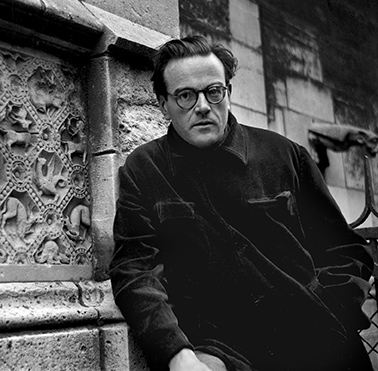
Sergio de Castro, 1950
Photo: Julio Cortazar
Selected exhibitions
Amsterdam, Fondation Peter Stuyvesant
Auxerre, Saint-Georges-sur-Baulche, Bibliothèque de l’Yonne
Berne, Bibliothèque Nationale Suisse, Fonds Georges Borgeaud
Brême, Kunsthalle
Caen, Monastère des Bénédictines du Saint Sacrement de Couvrechef –La Folie
Hambourg, Dietrich-Bonhoeffer-Kirche
La Défense, Hall d’accueil de la société Atochem
Luxembourg, Musée National d’Histoire et d’Art
Montevideo, Pavillon Martirené de l’hôpital Saint-Bois
Paris, Centre national des arts plastiques
Paris, Fond National d’Art Contemporain
Romont, Fribourg, Collégiale Notre-Dame-de-l’Assomption
Saint-Lô, Musée des Beaux-Arts
Sélestat, Frac Alsace
Vienne, Mumok
Vienne, Museum des 20 Jahrhunderts
Selected exhibitions
Taller Torres-Garcia, exposition collective, Ateneo de Montevideo, tous les ans de 1942 à 1949
Pintura Uraguaya, exposition collective, Galerie Comte, Buenos Aires, 1944
Augusto y Horacio Torres-garcia, Sergio de Castro, Jonio Montiel, exposition collective, Galeria Viau, Buenos Aires, 1947
Donation de los Santos, exposition collective, Museo provencial de Bellas Artes, Sante Fe, 1948
Concours Air France, exposition collective, Galerie des Beaux-Arts, Paris, 1951
Exposition personnelle, Galerie Jeanne Castel, Paris, 1952
Exposition personnelle, Galerie Bonino, Buenos Aires, 1952, 1956
Prix Buhrle, exposition collective, Galerie Kaganovitch, Paris, 1953
Exposition personnelle, Galerie Pierre (Pierre Loeb), Paris, 1954
Exposition personnelle, Galerie Van Riel, Buenos Aires, 1955
Dibujos de artistas argentinos, exposition collective, Galeria Bonino, Buenos Aires, 1955
Peintres contemporains présentés par René de Soliers, exposition collective, Centre Culturel International, Cerisy-La–Salle, 1955
Expositions collectives, Galerie Charpentier, Paris, 1955, 1956, 1957, 1958, 1960, 1961
Expositions collectives, Galerie Rive-gauche, Paris, 1955, 1958
Exposition personnelle, Galerie Rive-Gauche, Paris, 1956
Art Contemporain, exposition collective, Château d’Harcourt, Chauvigny, 1956
Sélectionnés de la Critique, exposition collective, Galerie Saint-Placide, Paris, 1956
Biennale Francia-Italia, Palazzo delle Arti al Valentino, Turin, 1957, 1959
Junge maler aus Deutschland und Frankreich, Kunstmuseum, Lucerne, 1958
Expositions personnelles, Matthiesen Gallery, Londres, 1958, 1961
Exposition collective, John Moore Foundation, Walker Art Gallery, Liverpool, 1959
Documenta II, Cassel, 1959
Peintres et Sculpteurs Argentins, exposition collective, Comité France-Amérique, Grand Palais, Paris, 1959
Recent Acquisitions, exposition collective, Arts Council, Londres, 1959
5th International Hallmark Art Award, Wildenstein Gallery, New York, 1960
Exposition collective, Sesquicentenario, Museo Nacional de Bellas Artes, Buenos Aires, 1960
Art Sacré, exposition collective, Musée d’Art moderne de Paris, 1960
Arte Argentina Contemporanea, Museum de Arte Moderna, Rio de Janeiro, 1961
Expositions collectives, Leicester Gallery, Londres, 1962, 1963
Expositions personnelles, Galeria Lorenzelli, Milan, 1963, 1964
Art Argentin actuel, Musée d’Art Moderne de Paris, 1963
Exposition personnelle, Galerie Bettie Thommen, Bâle, 1964
Rétrospective, Kunsteverein (110 oeuvres de 1955 à 1965), Hambourg, 1965
Art Contemporain, Palazzo Strozzi, Florence, 1965
Artes Visuales I, Museo Eduardo Sivori, Buenos Aires, 1965
Natures-Mortes, exposition collective, Obere Zaune Galerie, Zurich, 1965
Variationen über ein Thema, Städtische Kunsthalle, Recklinghausen, 1966
Rétrospective, Musée d’Art et d’Histoire (103 oeuvres de 1955 à 1966), Fribourg, 1966
Von Bauhaus bis zum Gegenwart, Kunsthalle, Hambourg, 1967
Zauberdes Lichtes, Städischeee Kunsthalle, Recklinghausen, 1967
De Lautrec à Matthieu, Musée d’Art et d’Histoire, Fribourg, 1968
Rétrospective itinérante (45 oeuvres de 1961 à 1966), Kunstforening – Holstebrö, Kunstforening
Oslo et Kunstindustrimuseet, Copenhague,1970
Racolta Pomini, exposition collective, Galeria Il Milione, Milan, 1970
Castro Landscape of Light, exposition personnelle, Wildenstein Gallery, Londres, 1972
Expositions personnelles, Galerie Jacob, Paris, 1972, 1974
Exposition personnelle, Château de Ville-d’Avray, 1973
Salon des Réalités Nouvelles, Paris, 1973, 1974
Expositions collectives, Galerie Jacob, Paris, 1973, 1996
Exposition personnelle, Galerie Monique Delcourt, Valenciennes, 1974
Foire de la Peinture, Düsseldorf, 1974
Exposition personnelle, Centre Culturel Français, Luxembourg, 1975
Rétrospective itinérante (91 oeuvres de 1965 à 1975), Kunsthalle de Brême, Tempelhof de Berlin et Kunstamt (Festival de Berlin), 1975
Rétrospective (68 oeuvres de 1956 à 1966), Musée des Beaux-Arts, Caen, 1975-76
Signe du Sacré au XXe siècle, exposition collective, Église Saint-Philibert, Dijon, 1977
Typographie-Écritures, exposition collective, Maison de la Culture, Rennes, 1978
Exposition collective, FRAC Alsace, Strasbourg, 1978
Le Regard du Peintre, exposition collective, Centre Georges Pompidou, Paris, 1978-79
Exposition personnelle, Galerie Valmay, Paris, 1979
Hommage à Pierre Loeb, Musée d’Art Moderne de Paris, 1979
1er Salon du Vitrail, Centre International du Vitrail, Chartres, 1980
Exposition personnelle, Association « Syn-Art », Paris, 1980
Rétrospective (12 oeuvres de grand format des années 1970), XXXIX Biennale, Pavillon de l’Argentine, Venise, 1980
Rétrospective (100 oeuvres de 1940 à 1974) Museo de Arte Moderno, Buenos Aires, 1987
Sergio de Castro à Atochem, exposition personnelle, Paris La Défense, 1987
Exposition personnelle, French Institute, Londres, 1987
Expositions personnelles, Galerie des Ambassades, Paris, 1988, 1989
Expositions personnelles, Galerie Galarté, Paris, 1988, 1995
Rétrospective (sujets religieux 1948- 1978), 1er Festival d’Art sacré contemporain, Musée diocésain d’Art Religieux, Bayeux, 1988
Rétrospective (48 oeuvres de 1972 à 1978), Hôtel de Ville, Sochaux, 1991
Donation Castro, exposition personnelle, Musée Suisse du Vitrail, Romont, 1991-92
Renaissance d’une Ville, Musée de Normandie, Caen, 1994
Artistas latino amaricanos en sus estudio, exposition collective, Museo Rufino Tamayo, Mexico, 1994
Exposition collective, Chac Mool Gallery, Los Angeles, 1995-96
Exposition personnelle, Galería Sur, Punta del Este (Uruguay), 1998
Salon d’Automne, Paris, 1999
Torres-Garcia et ses disciples, exposition collective, Galerie Ileana Bouboulis, Paris, 2002
Donation Castro, exposition personnelle, Musée de Saint-Lô, 2006-07
Exposition personnelle, Château de Gruyère (Suisse), 2008
50 ans de vitrail autour de Sergio de Castro, exposition collective, Musée de Saint-Lô, 2008-09
Exposition personnelle, Museo Gurvich, Montevideo, 2009
Francine Del Pierre et Sergio de Castro, exposition collective, Atelier Francine Del Pierre et Fance Franck, Paris, 2010
Mujeres esculturas – Varones pintores, exposition collective, Galerie Argentine, Paris, 2013
Hommage à Sergio de Castro, exposition collective, Galerie Orsay, Paris, 2013
Rayuela, el Parîs de Cortazar, exposition collective, Institut Cervantes, Paris, 2013
De l’Impressionnisme à l’abstraction. Festival Normandie Impressionniste, Musée des Beaux-Arts, Saint-Lô, 2013
Hommage à Jacques Thuillier, un historien d’art à Nevers, exposition collective, Musée de la Faïence et Médiathèque, Nevers, 2014
Otros cielos, exposition collective, Museo de Bellas Artes de Buenos Aires, 2014
Le vitrail contemporain de 1945 à nos jours, exposition collective, Cité de l’Architecture et du Patrimoine, Paris, 2015
Sergio de Castro, Figures et lignes, Galerie Diane de Polignac, Paris, 2022
Sergio de Castro, Les choses simples, Galerie Diane de Polignac, Paris, 2023
Selected bibliography
Jean Bouret, « À la découverte de Sergio de Castro », Art Paris, 1951
Pierre Descargues, « Sergio de Castro, 2 visages ? », Les Lettres Françaises, Paris, 1952
Julio E Payro, Sergio de Castro, Catalogue de l’exposition de la Galeria Bonino, Buenos Aires, 1952
Franck Elgar Carrefour, Sergio de Castro, 1954
André Chastel, « Un jeune peintre Sergio de Castro », Le Monde, 1954
Jean Bouret, « Les Constellations de Castro », Franc-Tireur, Paris, 1954
René de Solier, « Sergio de Castro », Nouvelle Revue Française, 1956
Cordoba-Iturburu, « Personnalité et raffinement chez Sergio de Castro », El Hogar, Buenos Aires, 1956
Mujica Lainez, « El refinamiento de Sergio de Castro », La Nacion, Buenos Aires, 1956
Denys Sutton, « Sergio de Castro », Apollo, Londres, N°394, décembre 1957
Denys Sutton, Sergio de Castro, Musée de Poche, Edition Fall, 1964
Hans Platte, « Sergio de Castro », catalogue de l’exposition Sergio de Castro 1955-1965, Kunstverein de Hambourg, 1965
Arnold Kohler, « L’univers particulier de Sergio de Castro », La Tribune de Genève, 1966
Denys Sutton, « Landscape of Light », catalogue de l’exposition Sergio de Castro, Landscape of light, Galerie Wildenstein, Londres, 1972
Claude Esteban, « Cosa mentale », catalogue de l’exposition Sergio de Castro, Galerie Jacob, Paris, 1972
Guy Weelen, Ceci regarde la peinture, catalogue d’exposition, Galerie Jacob, Paris, 1974
Antonio Bonet, « Correa Dualidad y Unitad en la obra de Sergio de Castro », Coloquio N° 21, Lisbonne, Fondation Calouste Gulbenkian, 1975
Gunther Busch, Rétrospective Sergio de Castro, 1965 – 1975, catalogue d’exposition, Kunsthalle, Brême, 1975
Hans Platte, « Sergio de Castro », catalogue de l’exposition Sergio de Castro, Musée de Caen, 1975-76
Collectif sous la direction Michel Laclotte, Petit Larousse de la Peinture, 1979
Jean-Marie Dunoyer, « Forme : Permanence et métamorphose du visible », Le Monde, 1979
Lydia Harambourg, L’École de Paris 1945-1965 Dictionnaire des peintres, Éditions Ides et Calendes, 1983
Georges Borgeaud, « L’œuvre de Sergio de Castro », Revue Lyra, N°250/251, Buenos Aires, 1983
Jacques Thuillier, Les Prophètes, Editiones El Viso, 1984
Etienne Chatton, Nouveaux signes du sacré, Coédition Loisir et Pédagogie, Lausanne, Fragnière, Fribourg, 1986
Denis Lavalle, « Sergio de Castro à Bayeux », catalogue de l’exposition Sergio de Castro, sujets religieux 1948 – 1978, 1er Festival d’Art sacré contemporain de Bayeux, 1988
Dora Vallier, « L’œil écoute », catalogue de l’exposition Sergio de Castro, Natures – Mortes 1958-1965, Galerie des Ambassades, Paris, 1988
Jean Dominique Rey, « L’atelier du Saint-Gothard », catalogue de l’exposition Sergio de Castro, Les Ateliers 1958 – 1969, Galerie des Ambassades, Paris, 1989
« Entretien de Jean-Dominique Rey avec Sergio de Castro », exposition Sergio de Castro 1972 – 1978, Hôtel de Ville de Sochaux, 1991
Roger Munier, « TERRE ARDENTE », Voir Paris, Deyrolle Éditeur, 1993
Marie-Pierre Colle, « Corcuera Sergio de Castro », Artistas latinos-americanos en sus studios, Noriega Editores, Mexico, 1994
Jacques Thuillier, Histoire de l’Art, Flammarion, 2002
Collectif, Sergio de Castro Soixante ans de création 1944 – 2004, Éditions Somogy et Musée des Beaux-Arts de Saint-Lô, 2006
Lydia Harambourg, « SERGIO DE CASTRO », textes rassemblés autour de J. Thuillier, Édition Somogy, 2006
Collectif, Sergio de Castro, catalogue d’exposition, Musée de Saint-Lô, 2007
Silvia Listur, Sergio de Castro, catalogue exposition, Museo Gurvich, Montevideo, 2009
Christina Rossi, « Sergio de Castro », Revue Pagina 12, Montevideo, 2009
Gianni Burattoni, « De la peinture retrouvée à la peinture transformée », exposition Francine Del Pierre, Sergio de Castro, Atelier Del Pierre- Franck, Paris, 2010
Michel Hérold, Véronique David (dir.), Vitrail Ve – XXIe siècle, Paris, Centre des Monuments Nationaux, Éditions du Patrimoine, 2014
Sergio de Castro, Figures et lignes, cat. exp., Galerie Diane de Polignac, Paris, 2022
Isabelle Leroy-Jay, « Les choses simples » in cat. exp., Sergio de Castro, Les choses simples, Galerie Diane de Polignac, Paris, 2023
ROBERTA GONZÁLEZ & SERGIO DE CASTRO
Face à face
Exhibition from July 7 to September 27, 2025
Diane de Polignac Gallery
2 bis, rue de Gribeauval, Paris
www.dianedepolignac.com
Texts: Mathilde Gubanski
Translation: Lucy Johnston
Graphic design: Diane de Polignac Gallery
© Diane de Polignac Gallery, Paris, 2025
Texts are author’s property
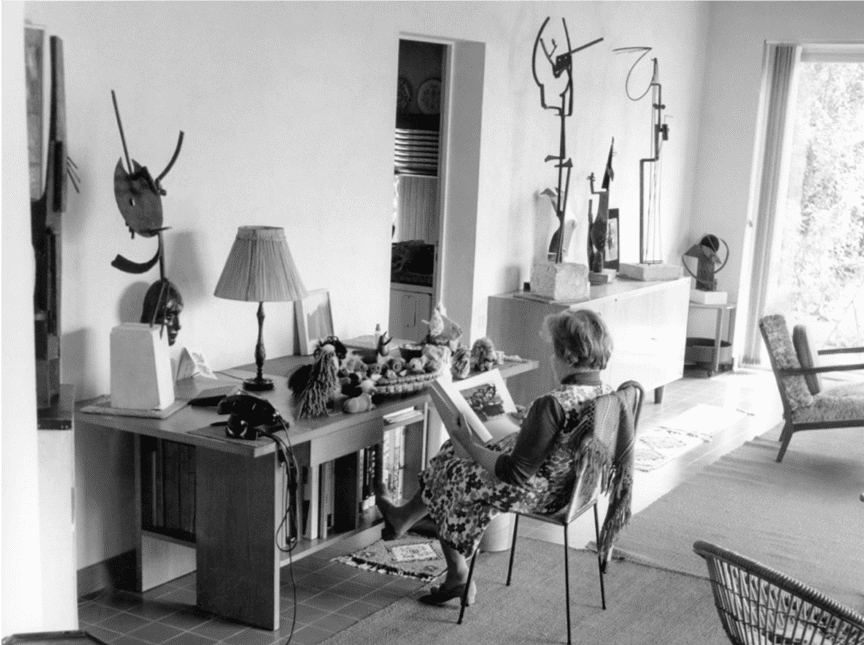
Roberta González reading, surrounded by sculptures by Julio González, at her home in L’Haÿ-les-Roses, 1960s
Photo: François Walch
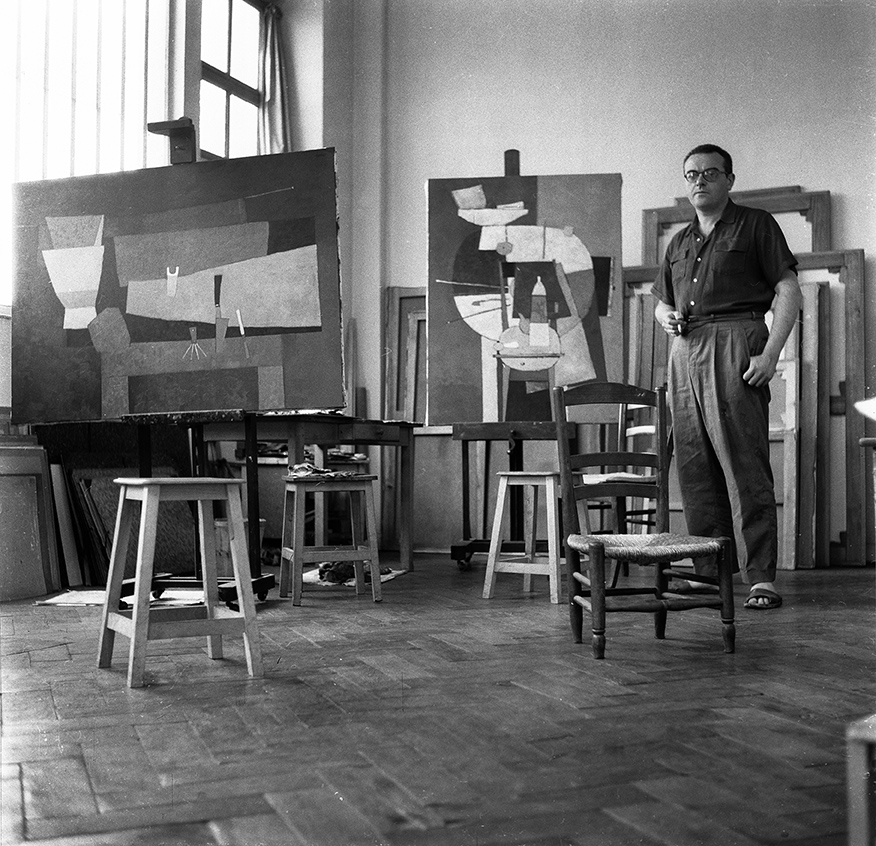
Sergio de Castro in his studio, Paris, 1954
Photo: Jose Antonio Mendia
